#White Cliffs Publishing Co.
Explore tagged Tumblr posts
Text


Sojourn #1: Kingdom of the Maggots
by Stephen R. Bissette
White Cliffs
2 notes
·
View notes
Note
14 and 29 for the fic writer asks
14. If you could see one of your fics adapted into a visual medium, such as comic or film, which fan fic would you pick?
Oh this is an easy pick for me! Absolutely it'd be Souls (which I'm going to be posting hopefully soon.); it has a lot of very strong visuals that would lend nicely to a visual format.
(Though, for published fics? Probably WTDS, since it's my baby at this point, lol)
29. Share a bit from a fic you’ll never post OR from a scene that was cut from an already posted fic. (If you don’t have either, just share a random fic idea you have that you don’t plan on getting to.)
Time to dig. I'm gonna share two different things: A bit from an old fic that'll never see the light of day unless somebody asks or I'm possessed by nostalgia, & a more recent one
Tears stain the snow, clear to break up the drops of red littering blue and white flowers; like fresh rain. And just like that, the moment is gone. There is everything and nothing left, emotions driving the scene more than visual. Fear, coiling and painful, anger, colourful and sudden, sadness, blue as ice and cold, and a distant, warm, sense of happiness. Victory, but at what cost? The cost of a field that blooms in forget-me-nots and daisies every sunrise, and those few weeks where windflowers break all odds and bloom, only to die off far too soon. The cost of a dead friend, an ally, a soulmate.
[ Excerpt from my plans for a oneshot in the 1000 Paper Cranes AU, forgive the writing, this is two years old, lol ]
The sweet smell of the purple flowers littered around spawn is a nice change from gunpowder and mildew. (He really should've fixed that pipe running into his base sooner, but he was busy and now it's too late to really fix well enough to count for much.) It beside his point, though. The flowers are nice, and maybe there will be more of them tomorrow. They spread like wildfire these days, just like the tall stems of sweet clover, and the bushels of lupine that have made themselves at home on rocky cliff faces and disturbed stone turned practically into gravel on the ground from the dozens upon dozens of explosives that have gone off within the vicinity. Maybe if he's lucky, Vitalasy will be here again, trying to fix up spawn. Though that would break the routine, and he's really rather that not change. It would mean having to avoid the path he's grown so fond of taking, heading toward a familiar set of co-ordinates that no longer lead anywhere. A place he's fondly not fond of. Where the old M.O.B. base used to stand, before the server got warped and reset to become "better", as he so distinctly remembers Parrot phrasing it. In his opinion, it's not so much better as it is different from how it used to be.
[ Excerpt from a oneshot I keep trying to finish, remembering I dislike the execution, and then promptly abandoning it again. ]
#ask a ghost#asker: anon#haunted bookshelf#for the snippets#also! apologies for not responding sooner lol#i had to Sleep
1 note
·
View note
Text
Black Voters Matter Statement on the Ahmaud Arbery Murder Trial Verdict
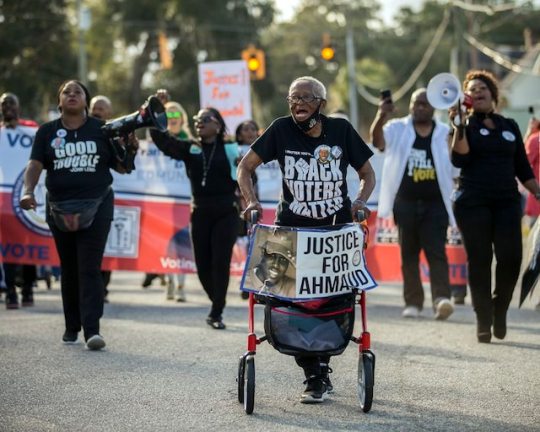
Today, all three defendants in the trial of the murder of Ahmaud Arbery, were found guilty of felony murder. All three men will now face hate-crime charges in federal court in February. Cliff Albright and LaTosha Brown, co-founders of Black Voters Matter, who supported local protests with the Transformative Justice Coalition and organizers on-the-ground, issued the following statement in response to the verdict:
“Every now and again our justice system gets it right. In the case of three white men who racially profiled, hunted and murdered 25 year old, Ahmaud Arbery, a jury of 11 white men and women, and one Black man, handed down a guilty verdict for slaughtering a man who was jogging while Black in his South Georgia neighborhood. This outcome is due in large part to the Arbery family whose relentless desire to seek justice for their son propelled the case forward.
“In fact, just as Mamie Till-Mobley insisted that the media publish photos of her murdered son, Emmett Till, 65 years ago to raise awareness and support for a trial, so did the Arbery family through their insistence on releasing the video of their son being murdered to the public. It was that act of transparency that really made this trial possible.
“However, much like the trial of George Floyd’s murderer, where the state attorney had to step in to prosecute the case, it’s very telling that the only way to get justice for Arbery — in a community that is 55% Black — was to take it out of the hands of local prosecutors, who had already demonstrated their refusal to prosecute the case fairly. A clear reminder that local elections continue to play an important role in the lives of Black voters.
“Furthermore, the defense’s case, fueled by racially-charged language, was deplorable, seeking to dehumanize Arbery at every step. Part of the ongoing demand for justice should include holding these attorneys accountable for their actions.
“But with all this said, we know that Wanda Cooper-Jones and Marcus Arbery will never get back their son.
“BVM stands in solidarity with Arbery’s family and the Brunswick community who supported them. We know this verdict is an indicator of how strong the will of the people is and how we can bring about change when we work together in pursuit of justice.”
Black Voters Matter, a 501c4, and Capacity Building Institute, a 501c3, are dedicated to expanding Black voter engagement and increasing progressive power through movement-building and engagement. Working with grassroots organizations, specifically in key states in the South, BVM seeks to increase voter registration and turnout, advocate for policies to expand voting rights/access, and help develop infrastructure where little or none exists to support a power-building movement that keeps Black voters and their issues at the forefront of our election process. For more information, please visit https://www.blackvotersmatterfund.org/
79 notes
·
View notes
Text
Contributor Spotlights: Emma Victoria and Julia Peronni
Welcome to She Wears the Midnight Crown and He Bears the Cape of Stars, two brand-new anthologies that share a common theme – masquerades – but tell different types of stories – wlw in She Wears the Midnight Crown and mlm in He Bears the Cape of Stars. These collections are the latest titles from Duck Prints Press, the indie publisher founded by fans to publish original works by fan creators, and they’re crowdfunding NOW, only on Seed & Spark!
Curious about the collections? Well, here’s a sneak peek of the works of two of our creators!

She Wears the Midnight Crown Contributor Spotlight: Emma Victoria
Biography: Emma Victoria was born an old soul, because you’re destined to be one when you’re given two old-fashioned names like that. She grew up with a taste for folklore and history and a penchant for going into the woods to have conversations with trees. As an adult, she’s dedicated herself to the study of photography and art criticism, but writing fantasy is a bedfellow she just can’t give up. After all, it’s the only way to meet dragons.
Link: Twitter
Story Title: The Scent of Roses
Teaser:
She was still wearing a single white dress-glove, the other one nowhere to be seen. Tris pulled it off, feeling the soft fabric catch on the callouses of her work-roughened hand. It had all been as much of a costume as the mask had been, but she had enjoyed it: not just pretending to be the kind of person who attended balls, but taking on the role the masculine clothes had afforded her. Women had curtsied to her and given her their hands to bow over; they had giggled and blushed over her compliments and let her lead them on the dance floor.
Just a few inches under six feet, Tris was tall for a woman, and had little in the way of curves. She kept her hair cropped short, and in her usual gardener’s slops she was, at best, a tolerated eccentric.
The masked ball and its anonymity had offered an interlude. Under the glittering candlelight, the borrowed doublet and the half-mask had transformed her from an undesirable woman into a lean and graceful young man in the eyes of the other revelers.
In her heart, Tris did not want to be a man.
She just wanted women to look at her the way they looked at men.
What harm could one night of deception do?

He Bears the Cape of Stars Contributor Spotlight: Julia Perroni
Biography: Julia Perroni (she/her) is a lifelong writer of fiction who was born and raised in not-so-sunny Vancouver, BC. She has been previously published in Geist Magazine and in several student writing contest anthologies, and writes on Archive of Our Own in various fandoms in her free time. Some of her favourite fic tropes include hurt/comfort, arranged marriage, and truth serum, but she’ll read (or write!) just about anything.
When she’s not writing creatively, she can be found in the library studying Ancient Greek for her ongoing graduate degree in Classics, working on her podcast, or out on the cliffs with chalk under her fingernails.
Link: Twitter
Story Title: Porcelain Skin
Teaser:
Favourite clients had come and gone over the years: some he saw only once, and had been delighted to work for; others every few years; still others once a year at least for three or four years in a row before they met their match and married, never to walk through his door again. Or so they hoped, of course. He’d had his share of widows and widowers, too, and always did his best for them.
But none were like James Elenbrook. The young lord had been through his door several times a year, every year since he succeeded his father as master of Elenbrook Grove. The first time, Benjamin had barely agreed to the job. He had been young and still building a reputation and resources from nearly nothing – he’d been nowhere near his current popularity – and it had been a very late order. In recent years, Benjamin’s time filled so quickly that he had considered creating some manner of waiting list. But he always saved a little slice of time for the man he wished he could know as James.
*
Intrigued? You should be! But, if you want to read the rest of these stories you’ll need to back our campaign, running now through July 14th, 2022!
Want to See Their Happily-Ever-Afters? Back the Campaign to Read the Whole Stories!
4 notes
·
View notes
Text
My Silver Screen, My Misery, My Love, My Defeat
Pairing: Billie Dean Howard x Fem Reader
A/N: I’ve been wanting to write something with Billie Dean for so long but didn’t know where to start. This lady intimidates me. I don’t know what this fic is worth, and I’m so nervous about posting it - I know it’s not particularly nice, but it’s the most personal fic I ever wrote so please be kind.
Title is from “Pacific Coast Highway In The Movies” by AWOLNATION. This song haunts me. x
Word count: ~ 3 000
“Dear me when will my life begin?” you sighed dramatically as you gathered your things.
“Bitch, I never want to see you again,” your boss growled, pointing an angry finger at you.
“Goodbye, asshole!” you called over your shoulder as you walked out of the room.
You had never cared about that job. You didn’t seem to be able to care about anything at all. You were so bored.
Real life lacked passion and colours. You were constantly hungry for a sense of wonderment. No emotion was worth feeling if it wasn’t extreme. You wanted to know how it felt to love so deeply you would faint in the dining room like the heroines of old, drive your car off a cliff, smash the heads of your lover’s suitors. When had the world and love become so boring?
You had come to believe you would never be able to fall in love with anyone. Fiction had ruined your life. You wanted beauty, you wanted glamour, you wanted passion and murder, tears shed under the stars, diamonds on the bed. You wanted a lover who would come down the stairs in a white silk gown with lace as the music and the lighting made love to her. Cherry pink lips and wavy hair, glitter in her eyes. How could anyone settle for less?
You walked into the bright sunlight and let the flow of pedestrians sweep you away.
**
You scanned the press room and sighed. Bored, you were so bored. Luckily the couches were comfortable, and the tea was good.
You worked for the local newspaper – nothing serious, nothing you were passionate about, but you had been struggling to make ends meet. You and another journalist were covering an annual festival celebrating “everything mystical and magical!” Bollocks, as far as you were concerned. But you loved festivals, you always had. There was something almost surreal about them, how time seemed to slow down, and space to narrow. A bubble would form, a dome, a world only a few were let in. Real life would stop for a while, and you loved that, because real life was boring.
The press secretary – Leo? Theo? who cared; he was uninteresting and badly dressed – waved at you from across the room. “She’s here,” he mouthed, meaning the medium you were to interview. You gave him a thumbs-up and sighed as soon as he turned his back to you. Notebook, pen, Dictaphone. Cup of tea - empty. Another sigh. You signaled to the old lady behind the counter at the far end of the room for another cup. She pretended not to see you. ��
“Asshole,” you muttered between gritted teeth. Someone on the couch next to yours – Steve? Pete? he had introduced himself the day before, he worked for a national TV channel, you couldn’t remember which one – laughed loudly at something someone else had said.
Your attention was suddenly drawn to the door. The press secretary was ushering a group of people in: a young man wearing jeans, a girl clutching files to her chest, a woman who walked in as if she owned the place, high-heels clicking, smile flashing.
Out of the corner of your eye you saw Pete (Steve?) point at her. “Man, that’s Billie Dean Howard,” he said in a breath.
“Who?” asked his companion.
“Oi, Miss Howard!” someone called – a photographer, jumping to his feet with his camera in his hands.
She glanced at him, offered him a polite smile; tilted her head on one side as she took a pose.
You gazed at her.
“Make sure the lighting is good,” she told the photographer.
The young man in jeans was buzzing around her, almost shoving a notebook into her face, muttering something about a timetable and how they were running out of time. She leaned away from him, holding out a perfectly manicured hand – pale pink acrylics, thin silver rings – to bat the notebook away. You saw her mouth twist in an annoyed kind of way, and then the press secretary nodded at you, and she turned, and her eyes met yours.
Her brow pushed up as a smug smile crept up her lips – plump, glittery beige lipstick. “Are you here for me, babydoll?” she called.
And just like that you were done for. For the stars were singing, and your heart was finally. Admiring. Entranced. Alive.
Oh thank all the freaking Gods, she had finally come.
**
You turned on the Dictaphone and grabbed your pen. Your hands were sweating.
“Ur,” you said. Billie Dean crossed her legs and folded her hands on her knee, smiling.
You had prepared for this interview, vaguely, but she had stolen all the words from you. Kidnap me, was what you wished to tell her. Ravish me. Take me away with you from this grey world and fill my mind and heart with wonderment. Make me your co-star.
“So, what do you think of the city so far?” was what came out of your mouth. You could have died of embarrassment.
Fortunately for you, Billie Dean loved to talk about herself, so you didn’t have to rack your brain for interesting questions.
You told her you had waited for her your whole life. You told her you meant it. She looked genuinely surprised, but then she smiled, a smile that seemed to suggest she had already forgiven you for that mistake. You realized that, probably, your passionate childishness was very funny to her, as were all those who had succumbed to it before you.
“The scariest spirit I’ve ever met?” She leant back on the couch, eyes staring up at the ceiling, lips curling into a smile. “I don’t get scared easily,” she quipped, and her smile turned into a smirk.
“Are you planning on staying here long?”
Her eyes sparkled. “Depends if I can find a cozy bed to sleep in and a pretty girl to smooch.”
Damn her, damn her – you were about to lean in and kiss that smug smile off her lips when the press secretary – damn him, damn him – appeared out of nowhere as in an uninspired script, squeaking “Time’s up!” as if time mattered, as if time hadn’t stopped the minute you had met Billie Dean’s eyes.
The young man in jeans pressed a cup of coffee into Billie’s hands. “Cathy’s waiting for you in the VIP room,” he said nervously. He glanced at you over the rim of his glasses. “You’re done here?”
“I – “You cleared your throat. Billie Dean was standing up, rearranging her hair, ready to leave, ready to forget already –
“You’ll have us read that article before you publish it, alright?” the young man was saying.
“Oh whatever happened to the freedom of the press,” Billie retorted. Her eyes flicked to you. “Don’t mind him.”
“I have a very cozy bed,” you heard yourself say.
For a second or two, you could have heard a pin drop.
**
Billie held your face between her hands as if you were made of porcelain, the first time she kissed you. You gazed into her eyes as if you were dreaming. “Who are you?” you whispered.
She laughed indulgently. “Don’t forget to breathe, darling.”
A breath in. She smelt of cigarette smoke and sage and something else, something like… you didn’t know. There was no word for it. She smelt like Billie Dean Howard, medium to the stars.
**
Billie Dean raised a toast to you and to the sun and said she couldn’t possibly live without either of you. You scoffed, rolled your eyes at her as if that wasn’t the kindest thing anyone had ever said to you. She noticed your reddening cheeks, and let out a chuckle.
“What? It’s a sunburn,” you lied, fighting a smile.
The midday summer sun was beating down on the Mediterranean, a soft breeze blowing and carrying the scent of the sea. You were spending the week in Monaco, a gift from Billie for your first anniversary. You closed your eyes, breathed in happily. The waiter brought your order, a bistro salad with warm goat cheese on toast for you, a slice of salmon and French fries for Billie. She flashed a smile at him, and his eyes sparkled.
“He’s in love,” you teased, tucking a strand of hair behind your ear.
“With me?” Billie assumed an innocent expression. “Why, I could not possibly believe that.”
You scoffed again. She smiled, pinched a thick slice of lemon between her thumb and index.
“We should come here every summer,” she said in a singsong, drizzling lemon juice over the salmon. “I love it here.”
“Ghost-free?”
She laughed. “I wish. But you look so beautiful with that sunburn.”Her eyes glanced up at you mischievously; you cleared your throat. She smirked, put the slice of lemon on the side of her plate, dried her fingers with her napkin.
“You and I, lost in a foreign country,” she said.
“Luckily for you, I took French lessons in college.”
“Oh is that so?” Under the table, Billie rubbed her bare foot up and down your leg. “And how do you say ‘kiss me’ in French?”
You leaned towards her, beaming. Your gaze flicked to her lips. “Embrasse-moi.”
“Atta girl.”
She took your breath away, every day. You bent over the table, meeting her lips halfway, smiling into the kiss.
**
“I love you,” she whispered. Her eyes smiled. “Forever.”
You pressed the pad of your thumb against her brow. “Um, you can’t know that.”
“Know that I love you?”
“Know that it’ll last forever. Nothing lasts forever.”
She pouted, shifted slightly on the bed. Your thumb slid on her skin. The light streaming through the windows splashed the walls of the hotel room yellow.
“Don’t be so mean at 8 in the morning,” she whined.
You rolled your eyes at her, planted a kiss on her lips. Her skin was hot and clammy. You nuzzled your nose in her neck, blew some air to tickle her. She raised one hand to fan herself – coral acrylics, no rings.
“Call room service,” she said, stretching lazily. “I want some ice cream.”
You snorted.“Ice cream for breakfast?”
“It’s too hot.”
You reached out for the telephone and sat up, making sure your bare breasts were exposed. “Lemon?” you asked Billie. She nodded, gaze on your chest. You made a face. “I don’t understand how you can stand the taste of lemon, it’s so sour – oh, hello. Yes, could we get some lemon ice cream, please? Ice cream, yes. Room 108. And you know what, a bottle of champagne as well. Yes.” You grinned at Billie, who, face half buried in her pillow, was laughing happily. “Thank you. Muchas gracias. Yes. Bye!”
**
“Miss Howard, please.”
“Oh babe, call me Billie.”
“A little further to the left, please Billie.”
“Who’s that with you, miss Billie?”
“Be a doll and fetch me my shawl, will you darling?”
The girl – Lucy? Lily? – nodded in awe and hurried off.
“A little further to the left, Billie.”
Someone turned on a projector. You squinted, gave Billie’s hand a squeeze.
“Miss Billie, who’s that charming young woman with you? Is she your date? Miss Billie, who’s –“
Camera flashes, everywhere. You felt Billie’s lips, feather-light, brush your ear. “Relax,” she whispered. “You look beautiful.”
All around you, you could make out dark shapes, nondescript, unimportant. Spectators of the show. Come to see her, come to see you.
“Miss Billie who’s that charming –“
“Paws off!” Billie laughed. She pulled you closer, hip bumping yours. “She’s all mine, gentlemen.”
You beamed at her, brighter than the projector. Camera flashes, everywhere. To capture the moment when Billie nipped your ear lobe and you threw back your head to laugh, one hand on her arm, in love, so in love.
**
“So what are we doing this weekend?”
You glanced up at her. “Aren’t you busy this weekend?”
Billie flashed you a smile as she sat down on the couch beside you. She laid one hand on your bare thigh, nails gently grazing. “Production’s delayed. I’m all yours.”
With a wince you removed her hand from your thigh. “I’m sweating,” you whined.
Her smile faltered, just a bit. “Aren’t you happy?”she asked. And then she relaxed and shook her head. “Oh, I’m stupid. You made other plans.”
“I’ve nothing to do at all.” You stretched and winced again. “I don’t know. I’m so bored.”
**
It happened again. And again.
You caught yourself looking at other faces in the crowd. No one held a candle to Billie Dean, you knew that. But still. You scanned the crowd.
You pretended not to notice when Billie held out a hand for you to hold.
**
The glamour was fading. The twinkle of the stars was being swallowed up by the morning light.
You had once visited a house. The wallpaper was peeling off, leaving ugly streaks of dirty grey or brown. The landlady’s nail polish was chipped.
**
Billie’s eyes were wide and rimmed red. You had never seen her look so sad.
“Wait,” she pleaded, her fingers – pale pink acrylics, vintage ring with a red stone – closing around your wrist to hold you back. “Surely we can talk – “She tried to smile, but it looked too broken, too scared.
“There’s nothing to talk about, Billie,” you said, avoiding her gaze. You hesitated. “I’m sorry. I really am.”
Her face fell. “But surely – “
“Are you here for me, babydoll?”
Her teeth sank into her lower lip and a tear rolled down her cheek, but you didn’t wipe it as you usually would. For this was how things always went. People left each other. Staying alive meant getting bored of the people you once loved. The credits roll. The movie ends.
You planted one last kiss on her lips as a sob pushed out of your throat. “Gosh but I loved you so much,” you cried. “I hadn’t been alive before you came. You taught me how to love and now I’ve died again and I’m lost without you. I’m forever lost without my love for you.”
You kept one of her scarves. It still smelt of cigarette smoke and sage and that something else – Billie Dean Howard, medium to the stars.
**
Colours faded to grey. You sank back into routine. Monotonous. Soporific. Boring. So very boring.
A year ago you would have expected the world to stop turning the minute you walked out of Billie Dean’s life. It didn’t. Days followed days, a succession of yesterdays and todays and tomorrows. Life went on, mocking you.
**
The smell of salmon filled the kitchen as you dropped the thick slices onto the burning pan. You smiled as Julie – a one-night stand that somehow had become more – made an appreciative noise. She was sprawled on the sofa, watching TV lazily, muttering “Boring” every time she changed the channel.
“Boring,” – another channel, “Boring,” – another channel, “Bo – oh hello there! Y/N, look, I spot a milf!”
You looked up as the anchorman’s face twisted into a fawning smile. “I’ve got Muriel here on the phone, from Portland, Oregon. Muriel sounds pretty worried. She wants to know if ghosts stay forever as ghosts or if they ever get to find peace.”
The camera cut to his guest – coral acrylics, no rings. The salmon’s grease sizzled on the pan.
“Nice pair of legs,” Julie was saying. “Come on, cameraman, don’t be shy, show us more!”
You shushed her.
“��� some of them have been dead for a very long time, I’m afraid,” Billie Dean answered with an affected nod of her head.
Your eyes were wide.
“And what about love?” the anchorman asked.
Billie quirked an eyebrow. “Love?”
“Do you think it’s eternal?”
**
“I can’t believe we’re leaving tomorrow!” your friend Henry moaned drunkenly. He tapped his foot on the pavement like a pouting child. “Couldn’t we buy a house on one of those hills and live here? I wanna live here. I don’t wanna live anywhere else.”
“I know,” you giggled, pulling on his arm. The night was full of lights. You hadn’t expected less from Los Angeles. You hadn’t quite been able to find the angels in the sky, though. You kept an eye out for them.
“The world isn’t fair because we’re poor.”Henry walked up to the nearest streetlight and hugged it. “I’m staying here. I’m not leaving.”
You giggled again, stretching your arms as if you were about to break into dance. The air was warm. For the past few days your heart hadn’t been quite so sad.
A car honked nearby, making you jump, and just as you were about to curse a woman shot out of the hotel on your left in a flurry of yellow and blue and nearly smashed into you – “Shit, look where you’re go – “ – brown eyes, gaze terrified, shoes in her hands, cheeks pink and – “Billie?”
She slammed back into your life like the female protagonist of a Hitchcock movie, running from danger in the moonlight with her hair disheveled and her dress billowing in the wind.
“Billie?”
You caught hold of her wrist and tried to meet her gaze. “Are you alright? What – what happened to you? Did somebody hurt you? Are you alright?” You poured questions onto her as if you couldn’t stop. Her eyes focused on you, and she ran a hand through her hair, and let out a nervous laugh.
And just like that you were done for. For the stars were singing, and your heart was once again. Admiring. Entranced. Alive.
**
“Never again,” Billie groaned into your mouth. She was holding your head firmly between her hands, devouring you, shivering, panting. “Don’t you dare leave me ever again.”
“I love you,” you moaned. You pushed her down on the bed, eyes flashing hungry and predatory as you took in the sight of her, all flushed and ready for you. “Forever.”
And as you dived in you could almost forget the taste of that one lie.
**
“What about love?” the anchorman asked. “Do you think it’s eternal?”
Billie’s smile faltered. “I’m not sure,” she answered slowly.
“Aw, poor chick got her heart broken,” Julie mocked.
“Lemon?” you asked her.
“Uh?”
“Should I put some lemon juice on the salmon?”
“I hope so,” Billie’s voice said. “I’m not sure – but I hope so.”
#ahs#ahs imagines#sarah paulson#sarah paulson x reader#billie dean howard#billie dean howard x reader#fics
184 notes
·
View notes
Text
Saturday 12 December 1835
8
11 ½
No kiss cousin getting up and a linen to prepare yet ready in 1 5 hour F38° and soft morning at 9 5 at which hour breakfast -sat talking to A- of the railroad till 10 10 - I have been grave ever since yesterday noon and the licence business A- thinks it is about the railroad and my aunt’s being poorly but I think more and more A- and I will not get on together forever and my mind turns to the thought of be at liberty again out from 10 ¼ till 12 with Robert Mann and co. all hard at work cutting and getting sods and sod-banking all against the puddle banks of the Lower fishpond - a capital job - Frank and Mark Hepworth (between the times of the Northgate soil carts coming) helping and told them to get another barrow-man
SH:7/ML/E/18/0144
came in at 12 a little while with my aunt then ½ hour with A- Marian had just sent her up this morning’s HX Guardian newspaper announcing the death of Miss Lucy Ann Edwards of Pynest at Torquay in Devonshire - Mr Harper came at 1 and staid till 3 ½ - had seen Mr Parker who proposed (an amendment agreed to [readily]) just instead of paying Mr Nelson etc vid. line 6 from bottom of p. 275 and the whole of p. 276 £200 now to last till March it would be better to give him £80 and the rest (on the certificate of Mr Husband that work to that amount was done) by £25 per time once a week or fortnight as required - I gave Mr Nelson junior (Stephen - the father’s name is James) a check, on the Yorkshire District Bank for £80 on demand for which Mr Harper took and gave me Mr Nelson’s receipt - the Nelsons clever men and honest, but cannot get on for want of money, and if they had completed this Northgate job, and got £200 or £300 by it, they would never think of taking another job till had spent all the money - and thus they have never anything to begin a job with - the Lodge going on pretty well - very well, but Booth will hew and do his work too smooth - too much soigné to be in character with the design - Gave Mr Harper all the calculations he had made about the water wheel and Washington’s levels of sections and of the drift and Engine pt and wheel - and Shay’s specification of a water wheel 30ft diameter and 5ft breast, and desired Mr Harper to see Mr Leather and take his opinion and pay him for this and for his coming over - Mr Harper to be here again on Monday fortnight the 28th instant - he gave me particulars of note to write to one or 2 wheelswrights to send specifications of wheels 30ft diameter and 5ft breast and call upon Mr Harper with them next Monday fortnight - the 29th instant at the White Swan Inn H-x - A- came in just before setting off to Cliff Hill to ask Mr Harper to shew her how to find the point of sight in a picture - this led to much conversation - no certain rule - no artist follows any certain rule, or even owns rules very rigidly - nothing but practise makes an artist - exampled several errors in the known system of perspective - mentioned the systems of Green and others - talk about Mr Brown who said he had a perfect system of his own but would not discover it would not tell it or teach it at the mechanics Institute where a class of 200 understood that they were paying him for teaching them all he knew - Mr Harper had offered to publish Mr Brown’s system and run all risks if he might share the profits, I think he said - but Mr B- declined this - Mr Harper said perspecticians proved the truth of their theory by Euclid i.8 I brought down Euclid but I could not see nor could Mr Harper clearly shew how this 8th proposition if 2 triangles have 2 sides of the one = 2 sides of the other equal each to each etc etc and the contained angle equal the 2 triangles must be equal - Mr H- said there was another proposition - he turned over the whole of Euclid but could not hit upon the proposition he meant - most of this passed after A- was gone when he entered a little more largely into the subject of Mr Brown - I shewed him again the drawing A- had brought down, one of Mr B-‘s - H- said it was very bad - a bad copy of an old engraving - waste of time to study or try to learn drawing by this means - should copy nature, and good pictures - Hardings Drawings Books very good - the 2 best books he Mr Harper knew were Harding on the use of the lead pencil £2.12.0 and Burnett’s hints on composition sight shade and colour - Mr H- very civil - said he would lend A- these works - send them here immediately on his return home and when here next spring would go out for an hour or two and sketch with A- - Mr Jubb came during Mr Harper’s stay - just saw him for a minute or 2 - my aunt very poorly he will come again tomorrow - his own proposal - A- off to Cliff about 2 ¾ - I out from 3 ½ to 5 35 - the men Robert Mann and co. had worked very hard and got the puddle-banks sodded up to the old level so that the plugs were put in and the water suffered to come into the pond again (1 masked by the sodding - the other 2 chained together by a staple driven into the top of each as I had mentioned - that a hooked stick might catch the chain and thus pull out both plugs at once and with ease) - dressed - dinner at 6 ½ - coffee - ½ hour with my father and Marian then till 9 35 writing out journal up to the end of Thursday that is to line 4 inclusive of page 275 25 minutes with my aunt till 10 10 pm at which hour F42° Soft damp day and soft damp night.
3 notes
·
View notes
Text
PETER BLAKE’S ARTICE IN DORSET LIFE EXPLORES CARTER’S TILES!
Peter Blake’s Article in Dorset Life on Carter’s Tiles! A fantastic read!
Carter’s Tile Manufactory
Peter Blake looks at the origins of the company that would become Poole Pottery
Published in August ’16

The famous ‘Welcome to Poole’ sign at Sandbanks
How many of the millions of commuters and tourists who use the London Underground every year give a thought to their surroundings, in particular the countless tiles which line the tunnels and decorate the stations? Very few, I am sure. If any do, perhaps they would be surprised to know just how many were produced in Dorset, a county not always considered to be in the forefront of manufacturing output. However, a small part of Poole was a major player in the production of tiles and other ceramics used in the building trade for nearly 100 years. This is the story of Jesse Carter and his family, and their impact on Poole from the 1870s onwards. Dorset clay has been used for pottery for thousands of years. Indeed, some of the earliest fragments of fired pottery which have been found locally go back to the Neolithic period, c. 3000 years BC. The clay was mainly used by local potters until the 18th century, when improving transport links led to an increased demand for the fine white plastic ball clay from potteries all over the country. The following century saw a massive building boom, with the associated demand for ceramics for the building trade, such as roof tiles, chimney pots, drainpipes, and floor and decorative tiles. To meet this need, a number of potteries sprang up around Poole.

Lovely detailing on this corner building at Julian Terrace in Southbourne, Bournemouth
One such was the Patent Architectural Pottery Company, founded in Hamworthy in 1854 to supply high-quality goods for the better class of builders. James Walker, an employee of this company, decided to branch out on his own, and around 1860 set up the Walker Patent Encaustic and Mosaic Ornamental Brick and Tile Manufactory on East Quay, Poole. He fairly quickly got into financial difficulties and came to the attention of Jesse Carter, an enterprising businessman who visited Poole often in the course of his work as a partner in an ironmongers’ and builders’ merchants in Weybridge, Surrey. He saw the potential for the ailing business and acquired the site, by now derelict, in 1873, renaming it Carter’s Industrial Tile Manufactory, later to become Carter & Co, with a subsidiary company called Carter Stabler and Adams being established in 1921, which eventually became the worldwide success that was renamed Poole Pottery in 1963. Born in 1830 in Abbots Worthy, the son of a bricklayer, Jesse Carter benefited from the building boom of the 19th century. A journeyman bricklayer in 1851, by 1861 he was a builder employing 49 men and five boys. There are records in Hampshire Record Office of a number of land sales involving Carter in the Winchester area during this period, and it is likely that he did well out of the growing demand for land in an area which was developing rapidly, with a big increase in the demand for housing following the opening of the railway station in 1839. In 1871 he was living in Weybridge, but moved to Poole soon after acquiring the pottery site, living first in Market Street, then later in West End House, a very imposing Georgian residence, which still stands. He began to expand the range of tiles produced at the pottery, alongside the old ‘Carter’s red’ floor tiles, producing more decorative glazed, modelled and painted wall tiles for the growing interior design market. By the middle of the 1880s, the business was thriving, and Jesse took three of his sons, Charles, Owen and Ernest into the company, Ernest sadly dying in 1887 of rheumatic fever at the age of 27. With the involvement of his sons in the business, Jesse started to take a less active part in the day-to-day running of the pottery and moved to West Cliff Road in Bournemouth, Owen taking up residence in West End House.

The Norton Free Library (now a Wetherspoons pub)
Owen was the driving force behind the introduction of decorative pieces and tableware into the repertoire of the pottery, in his capacity as Art and Technical Director. A friend and admirer of William de Morgan, who designed tiles for William Morris, Owen set up a potter’s wheel in a stable at the rear of West End House, where he started experimenting with the development of ornamental wares. In 1912, production of the more straightforward floor and wall tiles was shifted to the Hamworthy sites owned by the pottery, with the East Quay site concentrating on the more artistic end of the spectrum. Owen’s involvement with what became the world famous Poole Pottery ended with his death in 1919. Carter and Co produced their tiles over a period of nearly 100 years, from 1873 until the company was merged into Pilkington Tiles Ltd in 1964. In 1962, production was estimated to be 100,000 tiles per week, with the tunnel ovens on site using more gas than the whole of Salisbury.

The Poole coat of arms on Poole Bridge
Although the ornamental ware received more attention, the plainer output of the pottery was vital to the continuing success of the business. Carter’s supplied many of the tiles which line the London underground tunnels. They also produced relief tiles for the decoration of the stations, for example Bethnal Green, depicting London scenes. Carter’s was also responsible for the platform tiling for the Victoria line. The company produced blue plaques put up by the LCC, and later the GLC, for many years until they stopped making them in 1981. Other bread and butter work was also important, if unglamorous. The supply of glazed bricks and ceramic tiles for commercial premises such as pubs, butchers, cinemas and the like provided a lucrative business, allowing the more decorative side of the pottery to develop and flourish. Fortunately, a number of examples of these ornate frontages and signs still exist in our area, for example: the Branksome Arms, Commercial Road, Bournemouth, which is Grade II listed; the Goat and Tricycle in Westhill Road, Bournemouth (previously the Pembroke Arms); Westbourne Cinema (now Westbourne Club Grand Bingo); Jenkins and Sons, a 1920s butchers and fishmongers at Penn Hill, Parkstone (still called Jenkins and Sons, but now a café bar, with the facade preserved); the Welcome to Poole signs such as the one situated at Sandbanks; the Swan Inn and Poole Arms pub, both in Poole; and the Poole town coats of arms, displayed on Poole Bridge. Other examples can be found fairly close at hand, for example New Milton, Salisbury, Romsey and Portsmouth. Poole Museum would also be a good starting point for anyone interested in finding out more about Carter and Co’s output. For more detailed information, please look at the Facebook page of the Tile Lady, a local expert who provides illustrated talks and undertakes guided tours giving information about noteworthy buildings and tiled features in the Bournemouth and Poole area. If visiting any of these sites, try to do so on a sunny day, just after rain if possible, as the coloured tiles will be seen to their best advantage then, taking on jewel-like qualities.
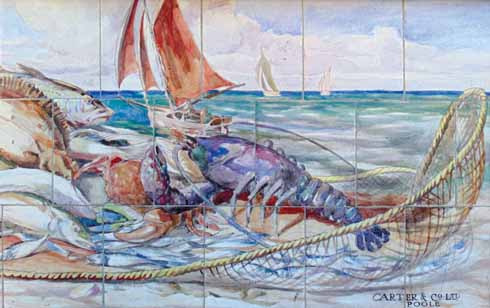
The front of Jenkin and Son in Parkstone
The Carter family had a long-lasting impact on the life and times of Poole, continuing right up to the modern day. As well as employing people at Carter’s and later Poole Pottery, another of Jesse’s sons, William, took over the ailing Kinson Pottery in 1884, making it a going concern. His son, Herbert Spencer Carter, OBE JP, went on to be Mayor of Poole five times, the first time in 1912 at the age of 32. In 1946, Herbert Carter Secondary School was opened, named in his honour. Still operating, now as Carter Community School, this establishment has educated many thousands of Poole’s children. Poole Pottery has attracted well-deserved fame for the innovative design and use of colour in its ceramics, spreading the name of Poole throughout the world and attracting countless visitors to its premises. Although the bulk of the manufacturing is now carried out at Middleport pottery in Staffordshire, new designs are still created, fired and painted in the Studio Pottery on Poole Quay, continuing the tradition going back over a century.

The Swan Inn in Poole
Jesse Carter died in 1927 at the grand old age of 96. Little can he have thought when he first saw a derelict and failing pottery in 1873, that the company he founded would have such a profound effect not only on his own family, but on the town of Poole as well. www.poolepottery.co.uk
2 notes
·
View notes
Link
Rest In Peace, Alex! - Phroyd
Alex Trebek, who became known to generations of television viewers as the quintessential quizmaster, bringing an air of bookish politesse to the garish coliseum of game shows as the longtime host of “Jeopardy!,” died Nov. 8 at 80.
The official “Jeopardy!” Twitter account announced the death without further details.
Mr. Trebek had suffered a series of health reversals in recent years, including two heart attacks and brain surgery, and was diagnosed with pancreatic cancer in 2019. He continued to host new episodes of his show until production was suspended in March because of the coronavirus pandemic, and then filmed socially distanced episodes that began airing Sept. 14.
For more than three decades, Mr. Trebek was a daily presence in millions of households, earning near-rabid loyalty for the intellectual challenge of his show, in which questions were presented as answers and answers were delivered in the form of questions. By the time of his death, “Jeopardy!” was one of the most popular and longest-lasting programs of its kind in TV history.
Mr. Trebek, the self-made son of a hotel chef, had no sequined co-presenter to match Vanna White on host Pat Sajak’s “Wheel of Fortune.” His show neither attracted nor allowed histrionics, no galloping, shrieking contestants such as those summoned to “Come on down!” on “The Price Is Right” with Bob Barker. Even the “Jeopardy!” theme song, one of the most recognizable jingles on television, was restrained in its dainty dings.
There was no “hot seat” like the chair for contestants on “Who Wants to Be a Millionaire?” with Regis Philbin — a show that “Jeopardy!” purists disdained for its elementary subject matter and inflated prize money.
On “Jeopardy!” there were only questions and answers — or rather, answers and then questions — leavened by the briefest of banter before Mr. Trebek directed his three contestants back to business.
He became known, a reporter for the New Republic magazine once observed, for his “crisp enunciation, acrobatic inflections [and] hammy dignity” as he primly — and with precise pronunciation — relayed clues in categories such as “European Cuisine,” “U.S. Geography,” “Ballet and Opera,” “Potent Potables” and “Potpourri.”
“The folding type of this cooling device became accepted in China during the Ming dynasty,” Mr. Trebek might declaim, as competitors raced to buzz in with the reply, “What is a fan?”
“Jeopardy!” was the creation of singer and talk-show host Merv Griffin, whose TV empire also included “Wheel of Fortune” and “Dance Fever.” His wife, Julann Griffin, proposed the show’s conceit. If players provided questions instead of answers, she said, then “Jeopardy!” would be safe from the high-profile cheating scandals that plagued TV quiz shows in the 1950s.
The Griffin brainchild aired on NBC from 1964 to 1975, then returned as “The All New Jeopardy!” from 1978 to 1979, both times with the stately actor Art Fleming as host. Mr. Trebek took over when the show was revived in syndication in 1984, also serving during his first several seasons as producer.
Much like his program, Mr. Trebek indulged in few frills. He favored conservative suits. When he shaved his signature mustache in 2001 — “on a whim,” he said — his viewership erupted in titillation.
The most exuberant flourish about the show might have been the exclamation mark in the title. Mr. Trebek, for his part, emitted few if any exclamations as he led contestants through the first round of clues; then a second, higher-stakes round dubbed “Double Jeopardy!”; and then “Final Jeopardy!,” in which players could wager all or some of their earnings on a single stumper.
“My job,” he told the Associated Press in 2012, “is to provide the atmosphere and assistance to the contestants to get them to perform at their very best. And if I’m successful doing that, I will be perceived as a nice guy and the audience will think of me as being a bit of a star. But not if I try to steal the limelight! The stars of ‘Jeopardy!’ are the material and the contestants.”
(Perhaps the show’s greatest stars were Ken Jennings, who reigned over the grid for 74 shows in 2004, claiming $2.5 million in winnings, and Watson, the IBM computer that defeated Jennings and another champion, Brad Rutter, in 2011.)
Fans who attended tapings of the show received a rare insight into Mr. Trebek’s dry humor when he held forth with them during commercial breaks, cutting up about how he didn’t “like spending time with stupid people,” which resulted in his having “very few friends.” He often regaled the crowd with tales of his DIY home-improvement projects.
He said his breakfast consisted of a Snickers and Diet Pepsi, or a Milky Way and Diet Coke. And he was not always as staid as he might have seemed, once tearing his Achilles’ tendon when he chased a burglar from his hotel room in 2011.
But to most “Jeopardy!” viewers, Mr. Trebek was akin to a neighbor they saw every day without becoming intimately acquainted. In a tribute to Mr. Trebek after his cancer diagnosis was announced, Jennings affectionately described him as “a riddle wrapped in an enigma wrapped in a Perry Ellis suit.” One of the few clues to his past was his slight Canadian accent.
George Alexander Trebek was born in Sudbury, Ontario, on July 22, 1940. His father was a Ukrainian immigrant, and his mother was French Canadian. In a memoir published in July, “The Answer Is . . . Reflections on My Life,” Mr. Trebek described a childhood marked by poverty and illness, including a painful form of rheumatism that he developed after falling into a frozen lake at age 7.
Mr. Trebek said that he considered becoming a priest but did not enjoy his experimentation with a vow of silence. “I was a very good student, but leaned more toward show business than anything else because I had a way of entertaining the class,” he told the Toronto Star. “I wasn’t the class clown, but always prominent — even when I was quiet.”
He said he was nearly expelled from boarding school and then dropped out of a military college after three days because he did not wish to subject himself to a buzz cut.
Mr. Trebek began working at the Canadian Broadcasting Corp. while studying philosophy at the University of Ottawa, where he graduated in 1961. As a broadcaster for radio and television, he delivered coverage in English and French, reported on news, weather and sports, and hosted “Reach for the Top,” a popular teen quiz show.
In 1973, Mr. Trebek came to the United States as host of “The Wizard of Odds,” a short-lived game show created by fellow Canadian Alan Thicke.
“It was canceled on a Friday, and I was disappointed, of course,” Mr. Trebek once said on “The Dan Patrick Show,” a sports talk program. “It was replaced the following Monday by a show called ‘High Rollers,’ which I also hosted. . . . After two and a half years, it was canceled, and it was replaced by another show which I hosted. So I have the either great honor or dubious honor of having replaced myself on three different occasions.”
Mr. Trebek, who became a U.S. citizen in 1998, also hosted shows including “Double Dare,” “The $128,000 Question” and “Battlestars.” He subbed for Chuck Woolery, Sajak’s predecessor on “Wheel of Fortune,” bringing him to the attention of Griffin. For a period Mr. Trebek hosted “Classic Concentration” and “To Tell the Truth” while also presiding over “Jeopardy!,” where he reportedly commanded $10 million a year.
As “Jeopardy!” host, Mr. Trebek participated in national contestant searches and shepherded the first teen, senior and celebrity tournaments. He also contributed clues, drawing from his knowledge in such arcane fields as oil drilling and bullfighting. He personally reviewed all clues before taping a show and claimed that he could answer about 65 percent of them correctly. If he judged one too difficult, he asked writers not to use it.
“I’ll say, ‘Nobody’s going to get this,’ ” he told the New York Times in a 2020 interview. “And they usually take my suggestions, because I view myself as every man.”
By the time Mr. Trebek completed 30 years as host, “Jeopardy!” reached 25 million viewers a week. His Emmys included a lifetime achievement award, and, in 2013, he ranked No. 8 in a Reader’s Digest poll of the most trusted people in America. Jimmy Carter, the highest-ranking president on the list, arrived at No. 24.
A ubiquitous presence in pop culture, Mr. Trebek appeared in the “Got milk?” advertising campaign, in films including “White Men Can’t Jump” (1992) and on television shows including “The Simpsons” and “The X-Files.” In a memorable episode of “Cheers,” Mr. Trebek welcomed as a contestant the postal carrier Cliff Clavin (John Ratzenberger), the sitcom’s most undesirable bachelor, in a round of “Jeopardy!” with categories including “beer,” “mothers and sons” and “celibacy.”
Mr. Trebek was spoofed on “Second City Television,” the Canadian TV sketch show, and “Saturday Night Live,” with comedian Will Ferrell, as his impersonator, barely containing his contempt for dimwitted contestants on “Celebrity Jeopardy!”
“I’ll take ‘Swords’ for $400,” Sean Connery, portrayed by Darrell Hammond, intoned in a Scottish accent when the category of clues was in fact “ ‘S’ Words.”
Mr. Trebek’s first marriage, to Elaine Callei, ended in divorce. In 1990, he married Jean Currivan. A complete list of survivors was not immediately available.
Little changed about “Jeopardy!” as the years wore on for the show, for Mr. Trebek and for fans. Newfangled topics, such as twerking, were occasionally introduced. Over time, contestants revealed themselves to be more familiar with Dan Brown, author of “The Da Vinci Code,” than with the English poet Samuel Taylor Coleridge, the New Republic noted. And Mr. Trebek was called upon to learn to rap to read certain clues.
But mainly the show stayed “comfortable, like an old pair of shoes,” Mr. Trebek once said. In its constancy, it became all the more comforting for the legions of fans who turned to “Jeopardy!” for its promise of clear right and wrong answers in a world where the matter of what is true was increasingly subjected to partisan debate.
“There’s a certain comfort that comes from knowing a fact,” Mr. Trebek told the Times in July. “The sun is up in the sky. There’s nothing you can say that’s going to change that. You can’t say, ‘The sun’s not up there, there’s no sky.’ There is reality, and there’s nothing wrong with accepting reality. It’s when you try to distort reality, to maneuver it into accommodating your particular point of view, your particular bigotry, your particular whatever — that’s when you run into problems.”
Phroyd
19 notes
·
View notes
Note
For definitely no reason whatsoever, in response to nothing specific, can you rank the DC Multiverse Earths and tell us a bit about why each is in its place on the list?
Were this in response to an article, I could assure that I generally enjoy the writer’s output perfectly well from what I’ve seen and was absolutely baffled by the bizarrely selective research that went into it. Anyway, I hope you feel guilty enabling the amount of work I put into this truly ridiculous task by the end.

Cliff notes for the relatively uninitiated: that gorgeous monstrosity up above is The Map Of The Multiverse from the miniseries Multiversity, presented as a series of concentric circles bordered by the ‘Overvoid’ that all of reality is suspended in (and framed in such a way as to make clear it is the white of the pages comics are printed on). You go inwards from the borders of creation - moving moreso with each sphere from abstraction to the realm of the physical - to the Monitor Sphere in which once lived the near-omnipotent, now nearly extinct Monitor race that observed and maintained the multiverse, into the Sphere of Gods where the various beings of myth and divinity dwell, and into the innermost sphere where ‘we’ live. The 52 Earths you see within aren’t the whole of the multiverse but the ‘local’ 52 worlds, with infinite other Earths dwelling in their own dimensional pockets; all these universes actually exist in the same three-dimensional space at the same time but suspended in a higher-dimensional substance called ‘the Bleed’, and vibrating at distinct frequencies. Also there’s a ‘Dark Multiverse’ that’s cosmologically speaking ‘beneath’ the map, disintegrating half-formed potential realities that new proper universes are culled from. There’s a lot more to it than even all of that, but that’s enough to explain what’s up with these.
My ranking here is obviously subjective, but mostly comes down to a mix of ‘how cool is this Earth’, ‘how much would this Earth be worth using again’, ‘how well does it work in the context of being part of a shared multiverse’, and ‘do I seriously see creators unearthing any of this Earth’s potential down the road’. Also, Earths 24, 27, 28, 46, and 49 aren’t here, as they’re among the 7 Unknown Earths on the map that were left behind for future creators to define; 14 and apparently 25 have since been revealed.
64. Earth 14

A worthy bottom-place entry, Earth 14 is at the top of the Multiverse Map, and is shown as physically different from the other Earths, seemingly vibrating as if in two places at once; map co-designer and illustrator Rian Hughes suggested in an interview the intent was that this was where new universes entered the multiverse. Instead, ending up the first Unknown Earth to be revealed after the doors were opened to other creative teams, it was shown as a generic dystopian world home to a ‘Justice League of Assassins’ that were quickly dispatched by a generic cosmic threat. A monumental tribute to contextual ignorance and creative laziness.
63. Flashpoint
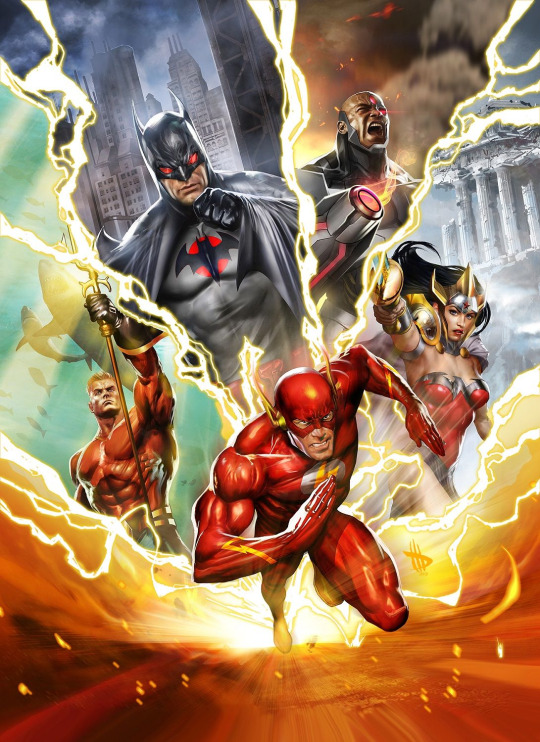
This is one of several Earths I’ll touch on that exist in neither the ‘local’ nor Dark Multiverse, but has directly crossed over or been framed in reference to the currently operating version of the DC Universe and so is probably worth a mention even if I’m not going over every Elseworlds and Imaginary Story DC has ever published. Another dystopian world, in this one an attempt by The Flash at fixing a change to history resulted in an Earth torn apart by war between Aquaman and Wonder Woman, where Cyborg was America’s greatest hero and Kal-El was held captive his entire life in a military bunker rather than becoming Superman. Aside from the prospect of a Thomas Wayne who became Batman when Bruce was gunned down as a child rather than vice-versa - resulting in him being pulled into a recent Batman run after this worlds’ destruction, the reason for this Earth’s inclusion - absolutely nothing of value came of this or the stories tied into it, such that astonishingly in spite of being the impetus for one of the biggest DC reboots of all time with theoretically an entire revised history to play with, essentially no one cares about this anymore.
62. Earth 1

The site of DC’s standalone, bookstore-market oriented ‘Earth One’ graphic novels. The incredible tunnel vision of marketing these for that purpose with titles that exist in reference to their multiversal structure aside, the Green Lantern book is the only one of those I’ve heard about being even kind of good; the rest top out at an interesting failure in Wonder Woman, with a standard forgettable failure in Teen Titans and truly flabbergasting misfires in Superman and Batman. Even Multiverse Map co-designer and writer Grant Morrison described this Earth in a blurb as having a history ‘in flux’, implicitly permitting the reader to believe it’s something else if they really want to, but as it stands in spite of the theoretical wide-open possibilities the foundations have already been built on salted Earth.
61. Watchmen

Home to the cast of characters of Alan Moore and Dave Gibbons’ seminal miniseries. Crossed over with the DC Universe 30+ year later in Doomsday Clock, which clearly intended to set up this world as one ripe for future stories and development rather than a singular text, but instead misinterpreted, stripmined, and otherwise nuked essentially everything that might have had one interested in exploring it further in the first place (in spite of the source text’s very definitive conclusions to all major narrative threads and characters). The only reason this is not ranked even lower is the possibility that the upcoming, as-yet untitled Watchmen project by Tom King and Jorge Fornes might manage to dredge something out of this.
60. Earth Negative 11

The first of the Dark Multiverse Earths here, a gender-flipped Earth where Bryce Wayne generically altered herself into an Atlantean in order to do battle with Aquawoman and the forces of Atlantis. As the Dark Multiverse worlds we have seen thus far are described as being borne of Bruce Wayne’s fears, it’s odd that as opposed to the ‘want of a nail’ scenarios shown on all others, this includes the additional twist of making Bruce a woman, yet does nothing with that. Anyway, this is a very clear product of the Dark Multiverse’s debut in Dark Nights: Metal wanting an evil Batman to correspond to each member of the Justice League, and it’s the oddest, most perfunctory of the lot.
59. Earth 34
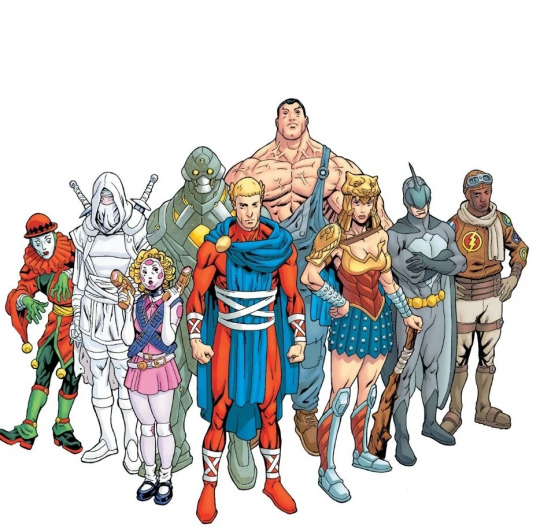
Home to the heroes of the Light Brigade, defenders of Cosmoville, this is an Earth meant to evoke the classic creator-owned superhero comic Astro City. However, as Astro City is itself made up of archetypal signifiers yet isn’t meta about its usage of them, being defined by its storytelling principles rather than the shared universe it builds up in the background, there are essentially no stories to be told here that couldn’t be told with the regular heroes of the DC universe. Which is a shame, those are some neat character designs.
58. Earth Negative 12
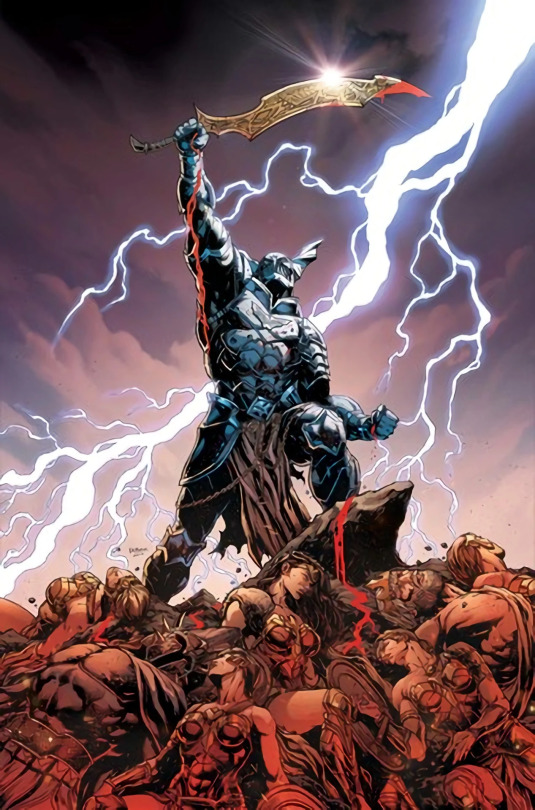
A Dark Multiverse Earth where believing Wonder Woman killed in a battle with the war god Ares, Batman took up the deity’s helm in hopes of redefining war, instead being corrupted by it and becoming an unstoppable monster. There’s basically nothing here.
57. Earth Negative 44

A Dark Multiverse Earth where a computer program meant to replicate Alfred after the butler’s untimely death, attempting to protect its charge, takes control of Batman by way of mechanizing him and turns Gotham into a digital nightmare. A little more on-point than the previous entry, but still not much here.
56. Earth Negative 22
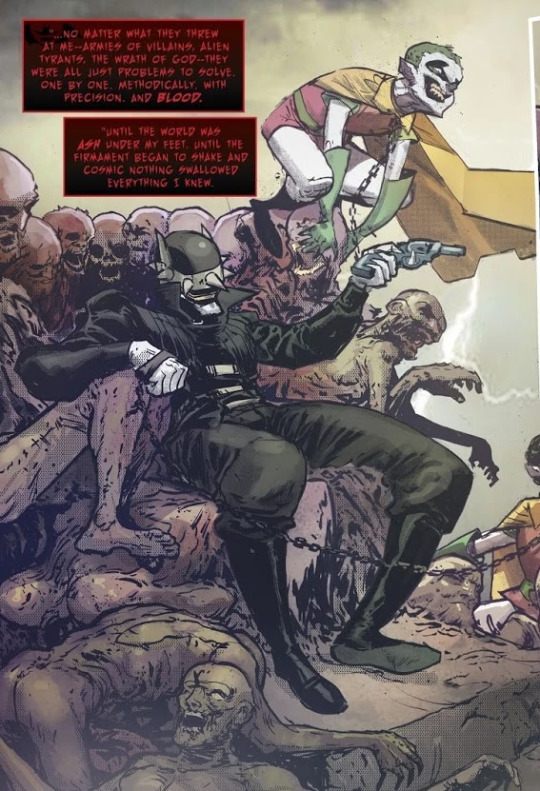
A Dark Multiverse Earth where Batman is finally pushed into killing the Joker, but the Clown Prince of Crime secretes a particularly potent Joker Toxin upon his death that corrupts the Caped Crusader into a second Joker known as The Batman Who Laughs, who slaughters his way across his universe before ultimately making his way to the ‘main’ DCU. The prospect of a Batman/Joker combination is interesting, but an origin for the ultimate corrupted Batman ‘he got drugged into going bad’ falls short.
55. Earth Negative 32
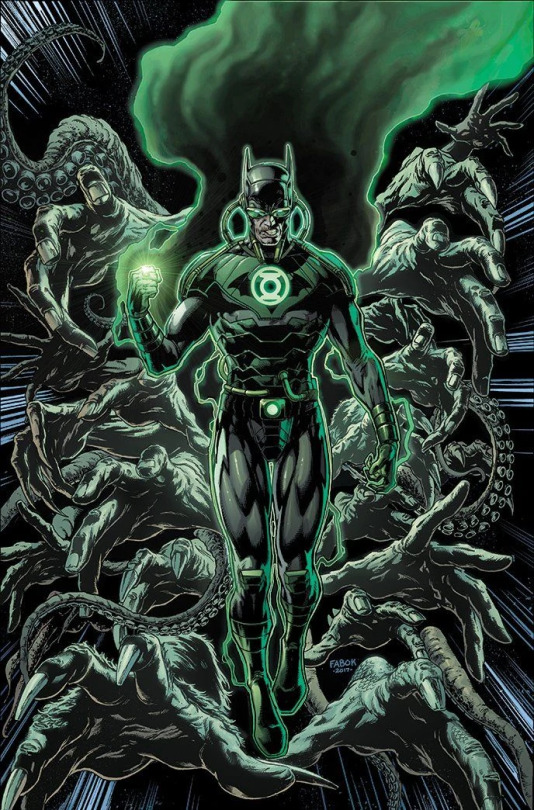
A Dark Multiverse Earth where Bruce Wayne moments after his parents’ deaths was judged worthy of a Green Lantern ring, but having only his hatred of crime rather than the discipline and morality he would come to develop becomes the murderous terror of the underworld, with even the Corps unable to stop him when he manages to force the darkness of his heart through the ring into ‘dark constructs’. Another ultimately throwaway Earth, this at least illustrates the properties of the Dark Multiverse in an interesting way: the constructs he creates aren’t something that’s ever been indicated as being possible or even sensible with the ‘real’ Green Lantern, but as this is a world literally made of nightmares that’s irrelevant.
54. Earth 39

Home to the United Nations superspies the Agents of W.O.N.D.E.R., who operating using super-technology with eventually deleterious side-effects. A pastiche of the obscure T.H.U.N.D.E.R. Agents, it’s hard to imagine anyone with much to say about them wouldn’t simply wish to write an actual comic about them under the current rights-holders, though the concepts described in Morrison’s provided information are enticing.
53. Earth 41
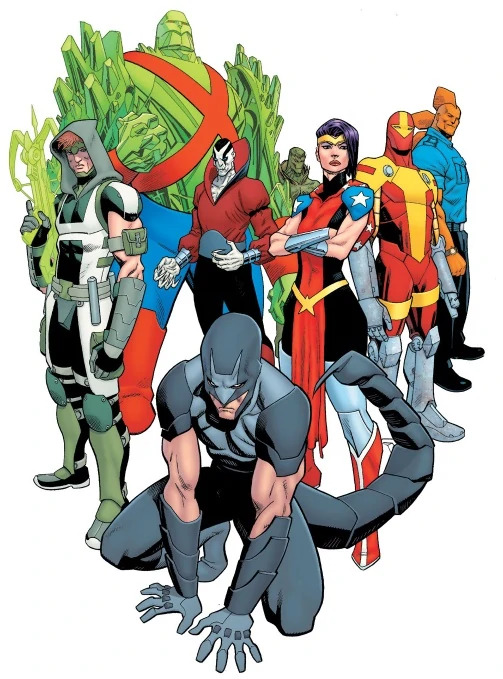
A riff on several of the superheroes published by Image Comics over the years, they’re worth having around for the occasional heroes of the multiverse groupshots for your big crossover comics and Dino-Cop turned out to be charming, but it’s doubtful someone with a big Spawn story in them for instance would use Spore as their outlet.
52. Earth 9

All I know about this is that this is a ‘what if superheroes really changed the world’ Earth, and when those are a dime a dozen, the additional conceits of the names of the various characters not at all corresponding to their traditional backstories and attributes, and being the brainchild of creator Dan Jurgens, are far from enough to sway me. I understand there are some fans out there who may heartily disagree, to be fair.
51. Earth Negative 52
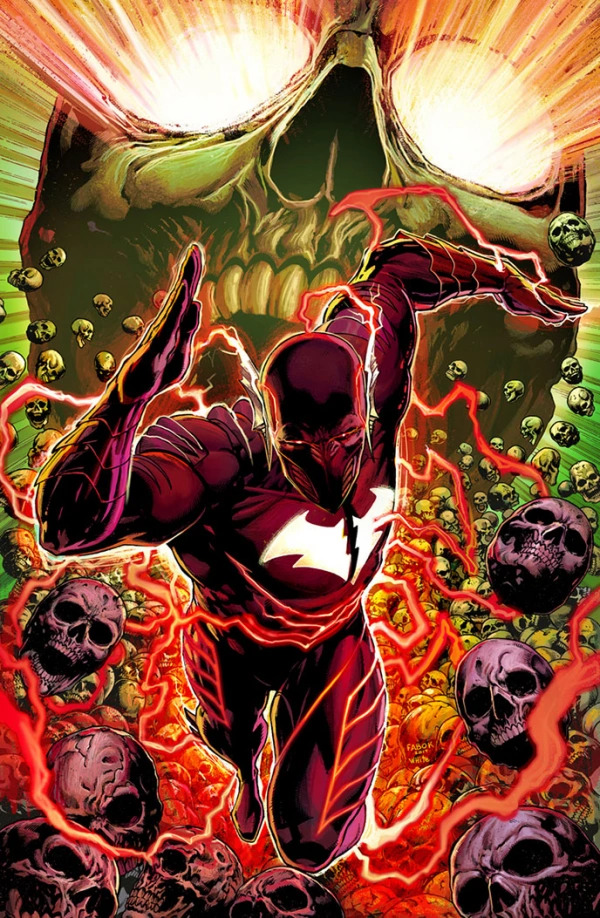
Another Dark Multiverse throwaway Earth, this time one where a Batman shattered by losing his various partners taps into the Speed Force so that he can finally be everywhere at once to stop all crime. This is distinct however in that he achieves this by defeating The Flash, chaining him to the hood of the Batmobile, and driving it so fast their atoms explode and merge, which is thoroughly rad and gets it big-time bonus points next to its contemporaries.
50. Earth 37
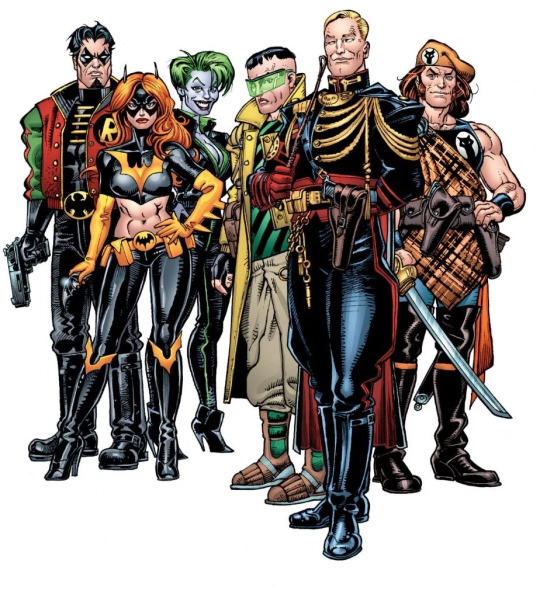
An Earth based on the DC works of creator Howard Chaykin, its conceit of being a world that progressed technologically far faster than our world but culturally remains decades behind us is interesting, but I’m not much of a fan of his work that I’ve read and most of what’s been drawn upon here doesn’t seem to have much of a following.
49. Earth 30
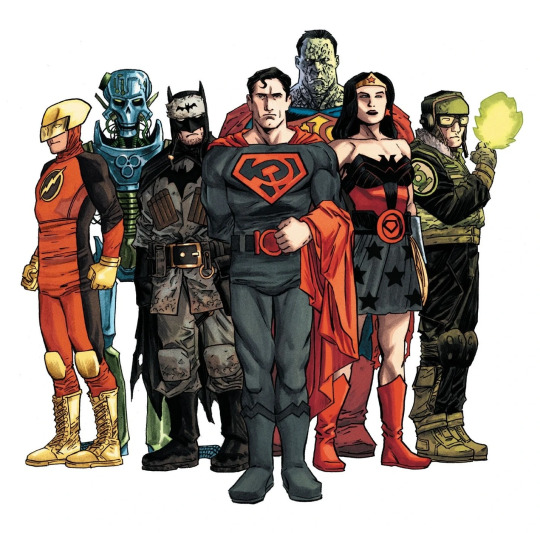
The world of Superman: Red Son, where Kal-L landed in the Ukraine and grew up to become leader of a global Soviet Union, before realizing he had deformed humanity’s development and faking his death. Leaving Earth in the hands of a Lex Luthor who while still very much a bastard found public approval in America for fighting Superman, Lex ultimately led Earth into a utopia that over time fell into complacency and became its universe’s version of Krypton, Jor-L (Luthor’s distant descendant) and Lara sending their baby back in time to survive and establishing a predestination loop. While several elements of the DC Universe are present in a limited capacity that could in theory be expanded on, Superman and Wonder Woman are the only superheroes of long-term note and both their stories are very much concluded, seemingly leaving little to do here except have the Superman with the hammer and sickle logo show up in event comics.
48. Earth 6
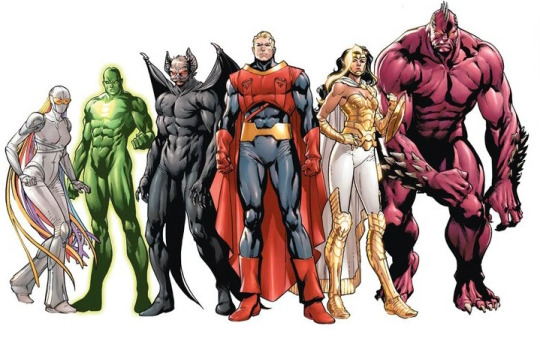
The world of the Just Imagine Stan Lee Created The DC Universe series, where the father of the Marvel Universe rebuilt several DC figureheads from the name and a few pieces of imagery up. The results were mixed at best, but a series of gorgeous artists involved in the projects mean the characters certainly look interesting even if it’s hard to imagine creators going back here in any meaningful capacity.
47. Earth Negative 1

A Dark Multiverse world where Superman turned on humanity for reasons unknown, and Batman deliberately infected himself with the ‘Doomsday Virus’ to gain the properties of the hulking monster and defeat his former friend. Now numbed to human emotion and vulnerability, this Batman hopes to spread the virus as to make humanity similarly indestructible, as well as shield them emotionally from what he has come to see as the false hope Superman represents. This Batman didn’t end up a major figure in the same way as The Batman Who Laughs, but the conceit is killer and I hope someone picks up on it one day.
46. Earth-52
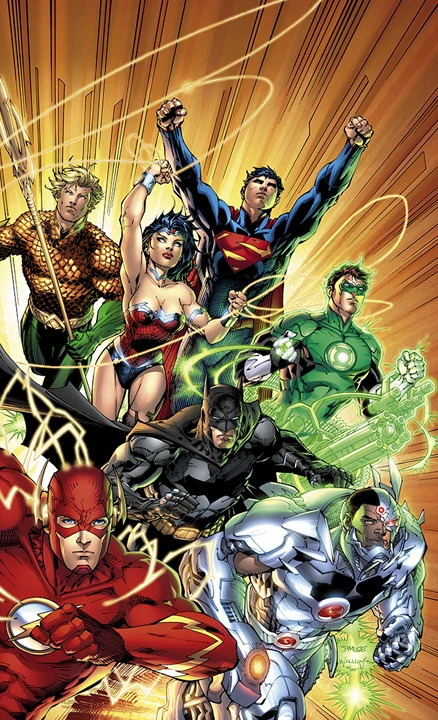
A universe somewhere outside the local 52, a ‘remnant’ of sorts of the main DC universe circa 2011-2016 prior to cosmic revisions resulting in the current setup. A world where superheroes had emerged approximately 5 years earlier and home to lots of dudes in very dumb battle-armor, most fan-favorite stories from this era have been carried forward into the current history, and its unique version of Superman under Grant Morrison - a socialist crusader in a t-shirt and jeans who battled corrupt institutions and cosmic supervillainy in equal measure - was depicted as set loose from his world after 2016′s continuity changes as a defender of the multiverse. While a significant part of DC history both in-universe and publishing-wise, there wouldn’t seem to be all that much left here worth exploring.
45. Earth 2
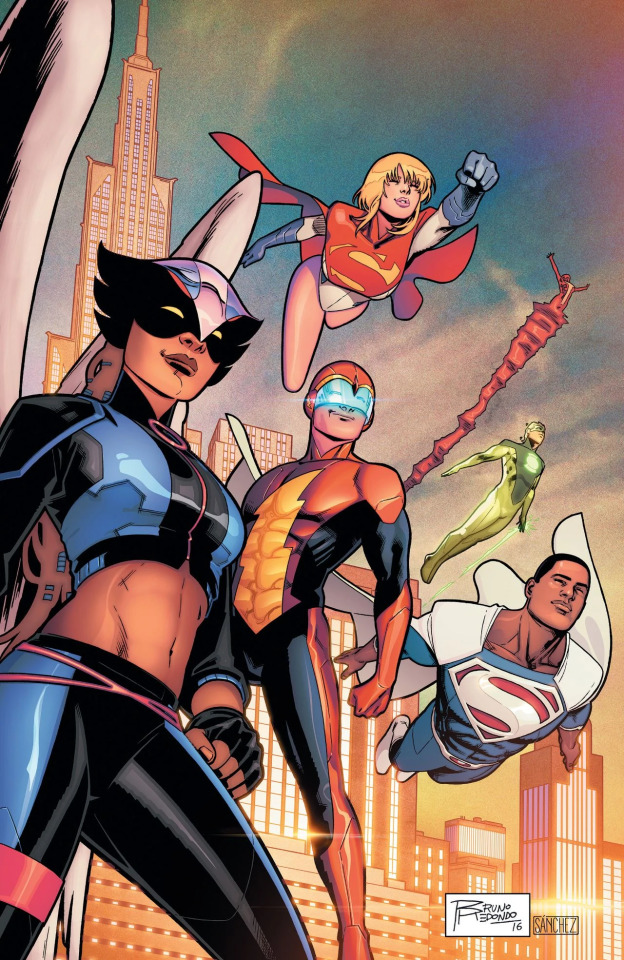
A world where Superman, Batman, and Wonder Woman alone represented the first wave of superheroes, they nobly fell in battle repelling an invasion of Earth by Darkseid. In time a new generation would emerge that were modernized, youthful iterations of the Justice Society of America, the superhero team predating the Justice League in DC’s publishing history. While the logline’s an interesting one and the successor to Superman Val-Zod debuted to some acclaim, for the most part this reinvention didn’t end up received well by either new or longtime fans, and a last-minute overhaul where this bunch was transplanted into a rebooted world without superheroes probably didn’t help. You still see them in crossovers and there are promising concepts, but this world seems basically dead.
44. Earth 50

When Lex Luthor ascended to the presidency and soon thereafter executed The Flash, Superman snapped, executed him, and took over the world alongside his allies as the Justice Lords, until they were ultimately overthrown by way of a parallel universe Justice League and a repentant Lord Batman. A Better World unequivocally rules, but given this is supposed to be those specific versions of the Lords rather than a new iteration, it’d be weird to see them up against any universe other than the DCAU. And, well...
43. Earth 12
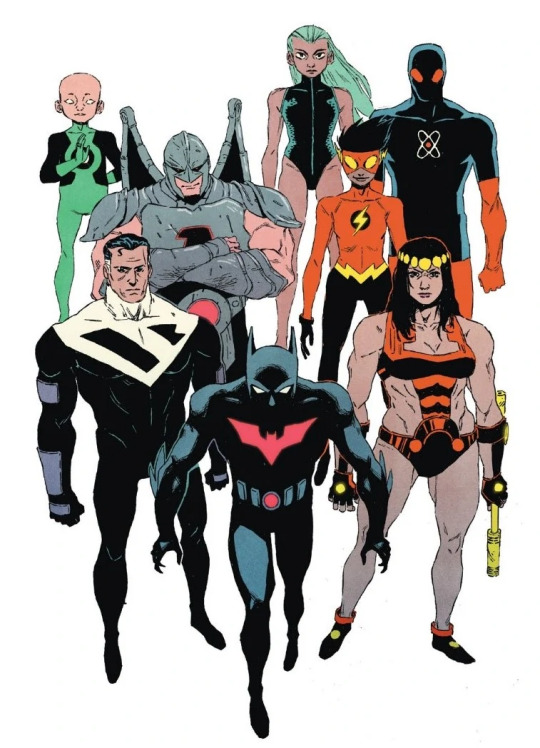
The DCAU, currently world of Batman Beyond and a future Justice League. The DCAU, you may be aware, extremely rules, but is also somewhat redundant in this context - the ‘regular’ DCU already has all its core components without too much aesthetic differentiation, and there’s already frequently a Batman Beyond in the future of said universe. It has its unique attributes that make people love it, it’s cool that it’s here, but on the macro scale it’s too clean an adaptation to bring much to the table to crossovers and whatnot, and you’d never see any further stories told there otherwise as really being part of the DCU cosmic landscape so much as a comic tie-in to the TV show.
(Also it’s odd this is placed here with the Justice Lords Earth as if to go ‘it’s secretly been part of the 52 all along, you just never noticed when it only crossed over with the one other!’ when there were two other parallel universes in the DCAU.)
42. Earth 43

A nightmare world haunted by the once-heroic, now vampiric Blood League, the obvious potential would be for this world to function as DC’s equivalent to Marvel Zombies. Recently however DCeased has come to fill that position, and while this world in practice if not concept skews more closely towards that source material as the former heroes still have vestiges of their old personalities - in theory distinguishing it as its own spin worth keeping around - it’s hard to imagine most takes on ‘Justice League but monsters’ won’t come out under the DCeased banner for the foreseeable future.
41. Earth 40

A world of pulp villains made to oppose Earth 20, these guys are simple but a hoot.
40. Earth 35 aka the Pseudoverse
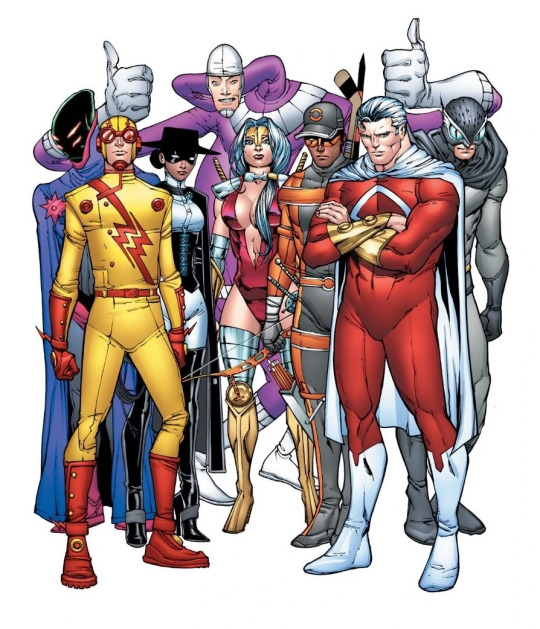
More analogues to analogues, this time of the Awesome Comics characters largely defined by Alan Moore in Supreme. This opens up the promising vista of ‘DC if it were designed by Alan Moore’, but in practice as demonstrated by his work with both DC and the analogues these mimic, that would just be...well, good DC comics, which you don’t need a whole extra universe for. The notion of this as a universe artificially created by Monitor ‘ideominers’ however both gives it a unique place in the multiverse, tackles its status as a pastiche in a unique way, and gets back to ideas of the power of imagination in both Supreme and Moore’s other works, so it’s likely there could be something to be done here.
39. Earth 11
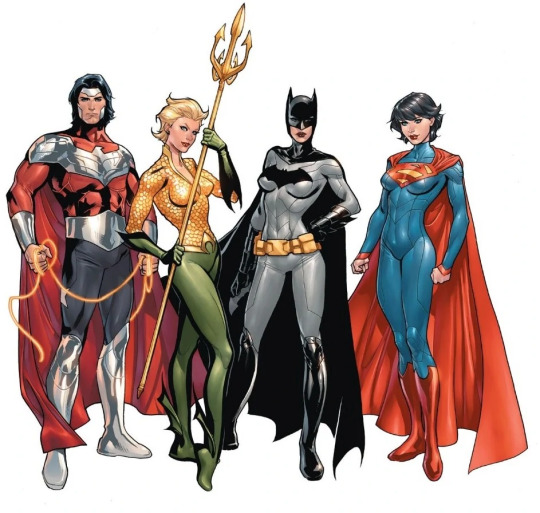
A bit of a study in contradictions. This is seemingly a rather straightforward ‘gender swap’ Earth with Superwoman, Wonderous Man, and so forth. Also, its version of Star Sapphire implied it’s not subjected to constant crises in the same way as the main universe it mirrors, maintaining a greater degree of consistency in the process. At the same time however it’s mentioned that the Amazons rather than leaving Man’s World for Themyscira shared its technology and philosophy with the world, changing it forever, suggesting a far different world from what we’ve seen in glimpses here. Until it decides one way or another whether it’s a simple mirror to the regular DCU or a radically different take, it hovers in a state of uncertainty.
38. Earth-2 aka Earth Two
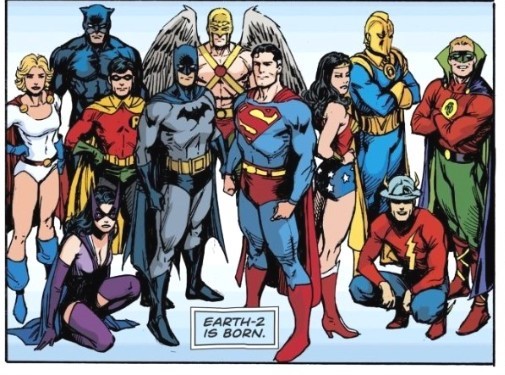
The original version of Earth-2, home to the DC Universe of the 1940s with aged versions of Superman and company and the original Justice Society of America. The first take on a DC universe that would progress in something resembling ‘real time’ rather than keeping the headliners as perpetual twenty-to-thirty-somethings, this was also the birthplace of heroes such as Power Girl and Huntress. I’m of the perhaps controversial opinion that this is a concept that was explored better in later takes: there’s a sense here that the largely forgotten follow-up generation eventually introduced, with the exception of the two heroes mentioned above, will never really matter in the same way as their still fully-active predecessors in spite of ostensibly taking over the family business, meaning you never quite actually get what you want here, which is to see a DC where things meaningfully change and move on - well into his middle age and his mentor’s death long behind him, Dick Grayson is still Robin. Add in the odd, ignominious demise of the original Batman and its Superman’s odd eventual fate - which slide from bizarre to intolerable if you accept the frequent implication that these are meant to be the original versions of them from the 1930s - and I can’t help but think the enjoyable high concept was never realized as well as it could be here.
37. Earth 4

The Earth of the characters of Charlton Comics who would go on to inspire Watchmen, this initially seemed like one of the most promising worlds after its debut in Pax Americana drew perhaps the most pronounced critical acclaim of any single issue in the past decade as the site for creators with something to say to work with Watchmen without actually touching that property. Now, however, Watchmen itself is in the mix: most wouldn’t reasonably go here while the material they’re truly referencing is now freely available (especially those simply wanting to draw fan attention by visibly playing with those toys, the way Earth 4 sidestepped) even though that world itself is now massively compromised past the original text, and with the ‘Watchmen Earth’ no longer an option and the characters themselves - if cleaned-up, more mainstream versions of them - existing in the DCU proper, this world’s role seems to have been largely stripped from it. I have to imagine there’s still potential here for those with the talent and commitment though.
36. Earth 44

A world where in the absence of natural superhuman beings, Doc Tornado created a Metal League of robot superheroes to protect the Earth. A promising concept definitely worth a few stories.
35. Earth 15
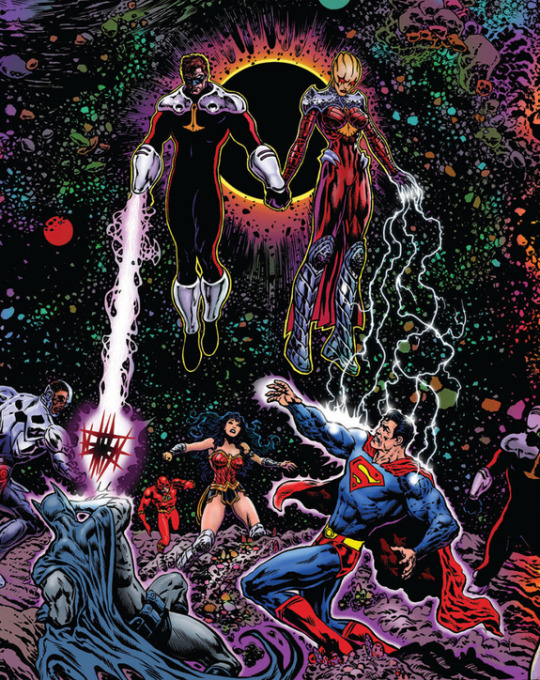
Once a perfect universe destroyed in a rampage by another Earth’s Superman, it was artificially reborn through the will of Countess Belzebeth - a cosmic vampire - as a copy of the Prime universe with the Green Lantern Corps replaced by Belzebeth’s despotic Blackstars, the uncertain and bitter heroes of this universe warped through the lens of Belzebeth’s perceptions of them had no chance against her forces. While its inhabitants are a bit samey what with all life having been subsumed into the diamond will of Blackstar Controller Mu, the idea of a conceptually weakened DCU being turned into an army against the rest of the multiverse makes for a terrific threat, and the prophecy of the ‘Cosmic Grail’ (a Green Lantern power battery lost somewhere in the multiverse) and that the First Lantern of the multiverse Volthoom hail from its original incarnation lend it some extra mythological weight.
34. Earth 32

A mashup world hosting the likes of the Justice Titans, Young Justice International, and the Doom Society. A world that’s home to Aquaflash will probably never have an ongoing all its own, but plenty of stories, miniseries, and even a brief line of comics have been based on mashup characters before, so there’s plenty of proof of concept for this being able to endure.
33. Earth 23

An Earth where Batman (naturally) is the only white guy on the Justice League, and Superman is not only President of the United States in his secret identity as Calvin Ellis, but the leader of the multiverse-spanning superteam Justice Incarnate. It reads like Morrison trying to do his idealized take on an ‘Ultimate DC’, a more diverse and politically engaged superhero landscape that doesn’t scale down its big ideas in turn, and if I were ranking it at the time it was introduced it would go much higher. The problem is that its version of Superman is modeled after Barack Obama, and that guy isn’t President anymore (and for that matter his legacy seems to grow more complicated by the year). As a result the vibe goes from triumphant to wistful mourning if not outright bitterly ironic, and that’s a needle that would have to be threaded before doing any substantial work here.
(Also, since several Justice Leaguers here rather than being made black are replaced with various black counterparts they’ve had over the years, that means Wonder Woman here is the 70s Amazon Nubia. And, uh, that name is something that would have to be...something.)
32. Earth 19
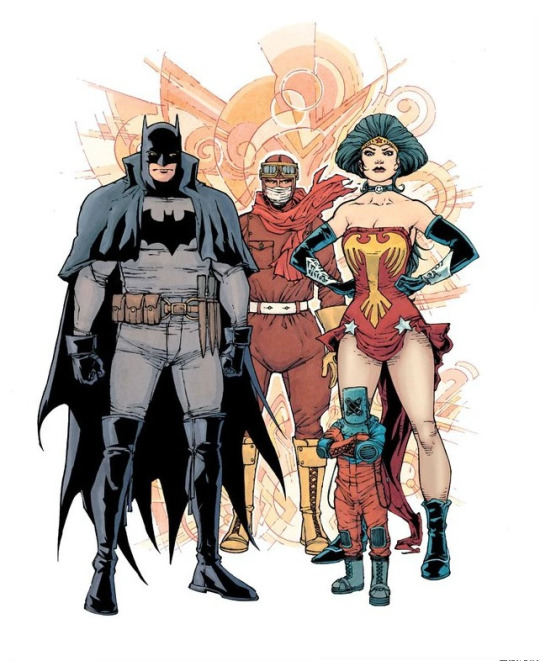
Steampunk superheroics; superhero period pieces are usually fun, and this is built on a foundation of pretty Mike Mignola art (though confession that I’ve never read Gotham By Gaslight), so sure, this one has potential.
31. Earth 18
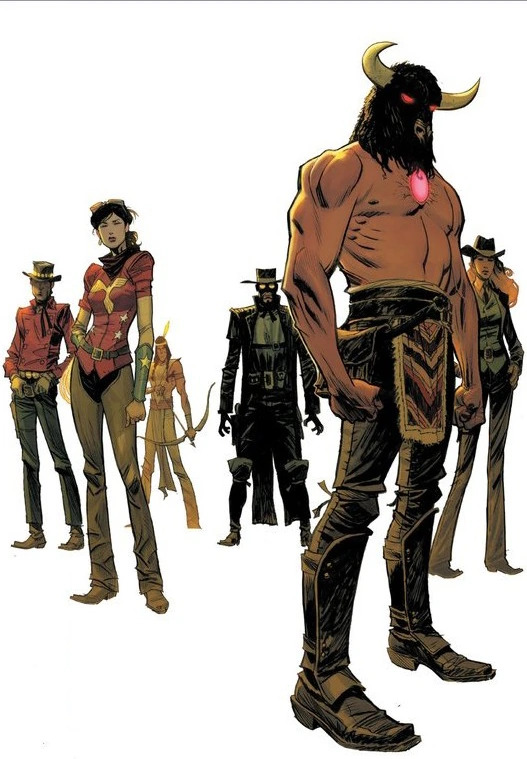
Same as above but cowboys instead. This gets extra credit because cowboys mesh better with superhero conventions, and the additional twist of this world being frozen in history by the Time Trapper, forcing them to approximate modern technology with 19th century resources.
30. Earth 31
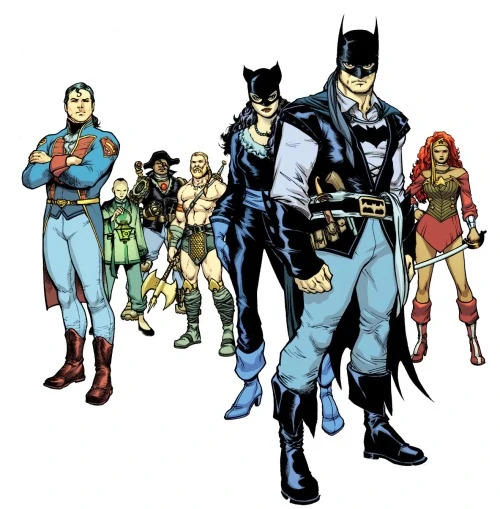
A post-apocalyptic waterworld where humanity is protected by Captain Leatherwing and assorted other pirate superheroes. Another ‘superheroes but in another genre’ setup, the post-apocalyptic, environmental twist makes it unfortunately more relevant than its peers, though I don’t think it’s quite the best end of the world as we know it on the list.
29. Earth 42

Home to the adorable, innocent world of the chibified Little League...secretly robots unwittingly enacting an endless stage play for the malevolent being known as the Empty Hand, running scenarios of his devising in preparation for a coming war with the rest of the multiverse. It’s a neat little multipurpose world, able to be played both as amusing contrast, or as parody whether light-hearted or cynical, in their endless ‘playtime’.
28. Earth 7
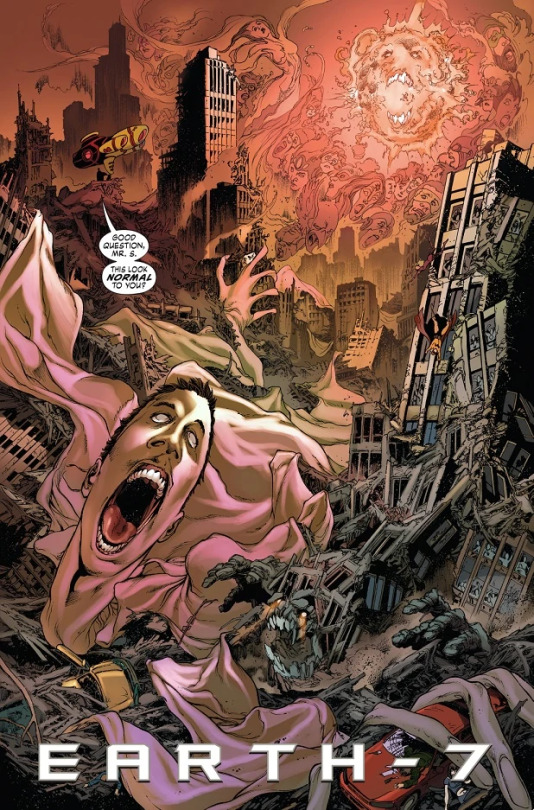
Formerly home to counterparts of the heroes of Earth 8, it was shattered by the Empty Hand’s forces and its desiccated cities made his throne, the zombie hordes that were once its champions his armies. The ‘Ultimate Marvel’ to Earth 8′s Marvel proper (and now Marvel Zombies), the idea of the broken remains of the cool version of the cool superhero universe as the lair of the ultimate evil has a certain appeal.
27. Earth 52

The last of the Earth 52s on this list, this newly added 53rd core Earth is home to Frank Miller’s Dark Knight books. Much as the reception to it over the years has become...mixed, at best (for my money Dark Knight III is the only one that’s not at least bad in a very interesting way, and even it still has its moments), the surprised generally positive reception to the most recent entry in Dark Knight Returns: The Golden Child suggests there’s still life in this oddball corner of the cosmos yet.
(Fun fact: this was Earth 31 in a previous version of the multiverse, and Morrison intended it to be included as such in Multiversity - hence why Earth 31 is made up of inky scratches on the Map - but Miller requested he not since he wanted to keep his domain separate from DC’s ongoing storylines. Instead he agreed later to Scott Snyder and Greg Capullo’s use of it in Dark Nights: Metal as DKR is famously Snyder’s favorite comic, bringing it in as Earth 52.)
26. Earth 47 aka Dreamworld

Where the Love Syndicate of Dreamworld dwells, baby: all is groovy. It’s incredibly specific in both era and theme, but a psychedelic universe with heroes to match invites tons of possibilities.
25. Earth 10 aka Earth X

It’s the Nazi Earth that sucks. It has superheroes who unnervingly are about as well-intentioned and effective as the standard set in the New Reischman, opposed by the few remaining dregs of the Freedom Fighters led by Uncle Sam; only their Kal-L, Overman, once Hitler’s weapon, truly understands the scope of the atrocities that led to their ‘utopia’, having grown a conscience too late and ever-aware that no feat in the present can ever redeem the oceans of blood on his hands. You can do horrifying introspective stuff with them as in their Multiversity chapter, you can tell Freedom Fighters stories like the recent miniseries, or you can just have the Justice League show up to fight the Nazi Justice League. A Nazi world is a standard one in multiverse stories for a reason, you don’t get easier targets.
24. Earth 5G

The DC universe that’s...sort of here and sort of not. Doomsday Clock and other upcoming stories appear to be shifting us over to this, but in most of DC’s line of titles the leap hasn’t taken place yet. As we haven’t seen the bench of successor heroes apparently primed to take over only so much can be judged, but the vast changes suggested by the new ‘official timeline’ that’s been leaked suggest a bizarre attempt at incorporating as many of their editorially-favored biggest hits as possible into a bizarre selective mishmash, without particularly serving the status quos any of the constituent characters said history is meant to bolster (with the exception of Wonder Woman, now framed as the first superhero, which would at least be interesting and a deserved bolster to her profile if there were any particular impression her new standing would be meaningfully followed-through on), while also not only reinstating the mutually destructive retcon of the JSA as preceding Superman, but taking the absurd extra step of actively presenting them as his inspiration. Of course we haven’t seen it in practice yet, and at the end of the day good stories will surely still be told here, but the foundations here are about as shaky as they’ve ever been for the ‘core’ DCU as a wholehearted capitulation to placing dotting all the i’s and crossing all the t’s over the actual narrative logistics of making a shared universe function smoothly.
23. Earth Negative Zero aka Betwixt
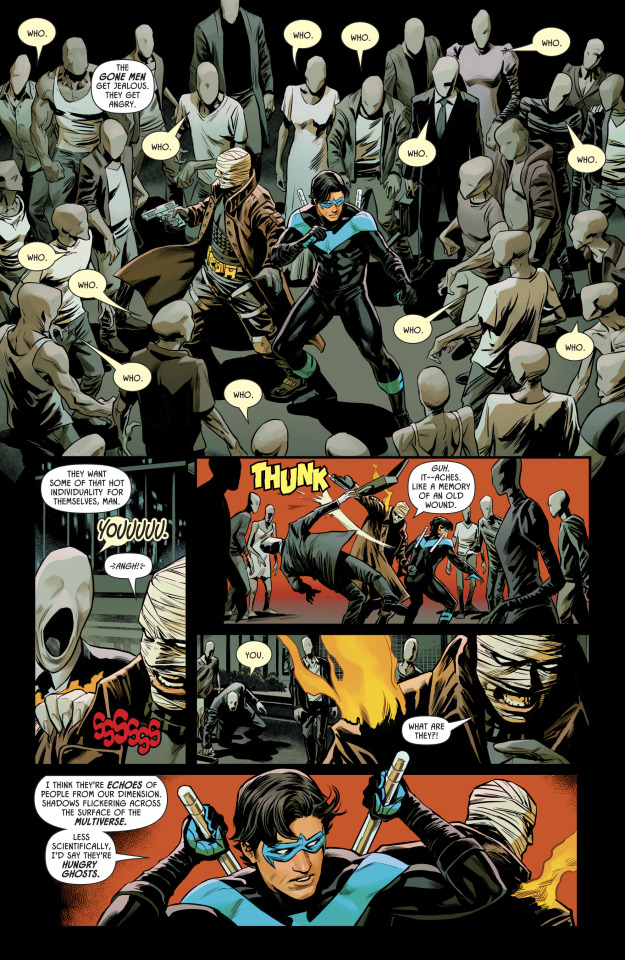
A world where those whose senses of self entire disintegrate fade away to seeking to feed on those still well-defined, this bears similarities to the realm of Limbo where ignored superheroes reside, but with just enough conceptual differences and a hellish, malleable twist that makes it the best thing anyone’s come up with to date to do with the Dark Multiverse.
22. Earth 48 aka Warworld
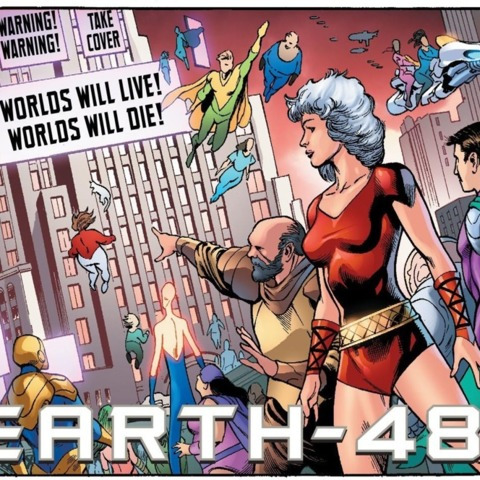
While its iconography is rooted of all things in castoff characters from Crisis On Infinite Earths and no-hopers from Countdown To Final Crisis, the actual conceit here of a world where literally everyone and everything is a superhero that operates by superhero rules, a world built by the New Gods as defenders of reality, is wide-open and tantalizing.
21. Earth 38
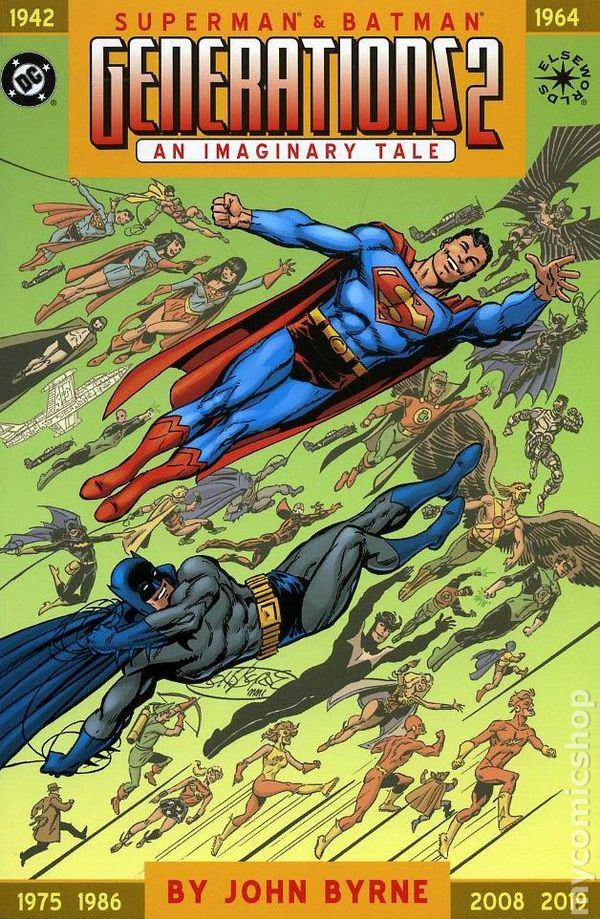
Another major shot at a DCU that aged in real time, this version has its own idiosyncrasies but far more of a sense of forward momentum and meaningful change, with the original Superman and Batman still leading the pack one way or another but successors to both them and the rest of the heroes truly stepping up. Also the predominant hero of the 21st century is Knightwing, the grandson of both Superman and Batman who has only partial Superman powers but also Batman training, which is just really cool.
20. Earth 3
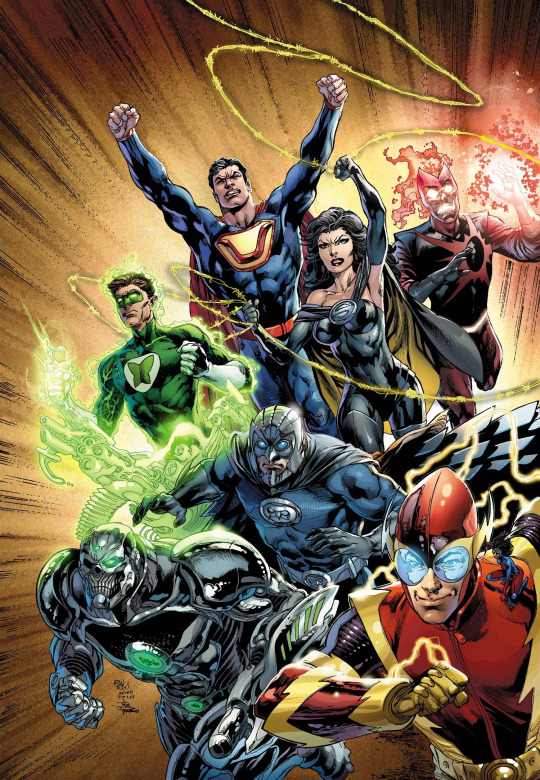
The good ‘ol classic evil mirror universe, where strength is the only law, the forces of evil always win in the end no matter how bright the day may become, and thus the Crime Syndicate operates as it pleases. It’s never quite as interesting as you want it to be - its villains are largely one-note - but its warped societal and cosmic rules, and that each character has a handful of twists on the mythology of their counterparts rather than being an exact (if morally inverted) duplicate, means it could easily one day come to live up to its obvious potential in the right hands.
19. Earth 21
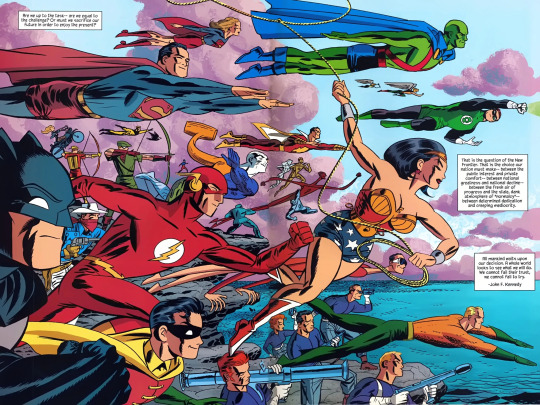
Here, most superheroes were forced into retirement after World War II by McCarthyist paranoia, but at the dawn of the 1960s the few remaining and a new generation are emboldened to step back into the light, spearheaded by the Justice League of America. DC: The New Frontier is a modern classic, with a direct standalone follow-up virtually out of the question; as it doesn’t quite lead into the world of the actual 1960s DC Comics either, its sole function in its capacity as a world in the multiverse is as a 60s ‘period piece’ Earth. Given that’s where most of the architecture of DC as we now know it was built however, that’s hardly a problem.
18. Earth 26 aka Earth C
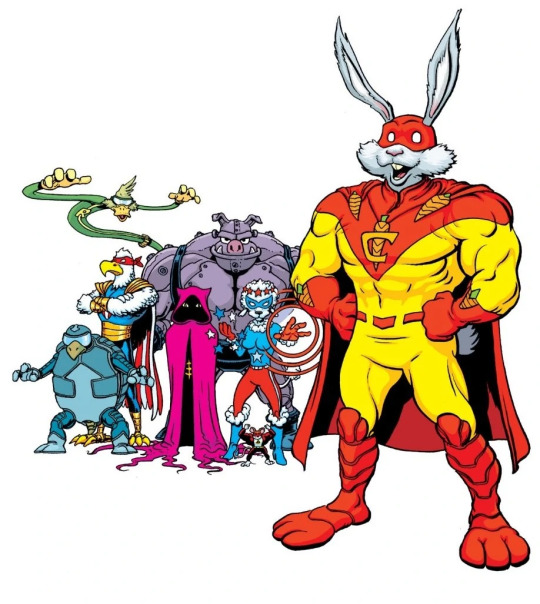
Funny animals are fun, and in a superhero universe that means you get superhero funny animals, courtesy of Captain Carrot and his amazing Zoo Crew. What’s not to love?
17. Earth 22
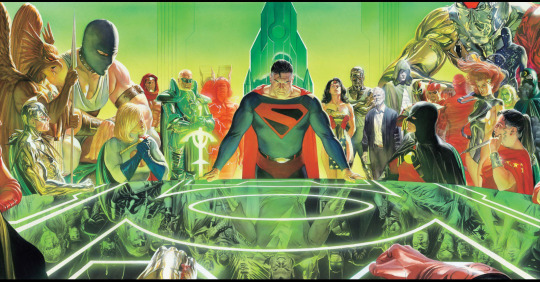
While time has somewhat dimmed the acclaim that originally surrounded it, Kingdom Come and its tale of a Superman coming out of retirement alongside his allies to try and reign in an out-of-control new generation remains a landmark moment in the genre, and in many aspects still holds up. Unlike many stories of its stature this world has always played nice with the mainline universe in terms of guest appearances and crossovers, including works by the original creators Mark Waid and Alex Ross, and as the most iconic and conceptually expansive work to date set in a DC universe that has joined in the march of time, that makes it a prominent and useful one to have around.
16. The Antimatter Universe of Qward aka The Reversoverse aka the Anti-Verse
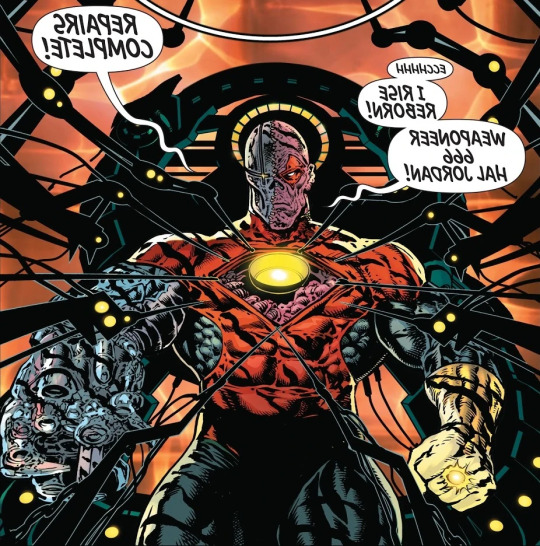
The original dark flipside of DC reality, this has occasionally also played home to the Crime Syndicate - and their best stories by far, to boot - but mainly serves as a home base to the Weaponeers of Qward and occasionally Sinestro. While largely unexplored it has a massively central place in DC’s cosmology and the birth of the multiverse, the glimpses of a society of pure evil in early Silver Age Green Lantern and JLA: Earth 2 are far more fun and interesting than anything seen in Earth 3′s history, it’s about to get even more room under Morrison to find definition, and as the ultimate mysterious Forbidden Realm of the DCU the possibilities could be essentially endless in the right hands.
15. Earth-1985 aka Earth One
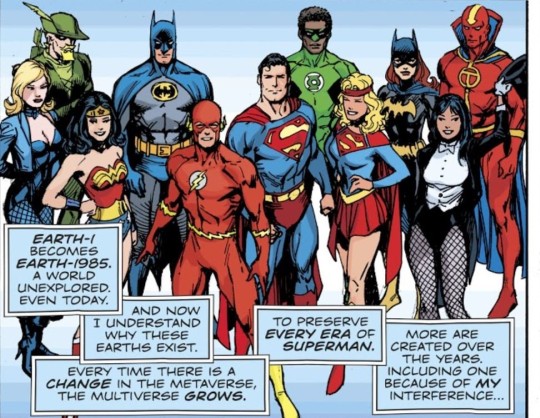
The DC universe of 1956-1986, and the dragon an entire generation of creators have spent their livelihoods chasing as the ‘classic’ iteration, as evidenced by one of them flat-out confirming it still exists somewhere out there. While that makes it frequently redundant when the main DCU is trying hard to mimic its feel - a few divergent notes such as Maggin’s idiosyncratic take on latter-day Superman and its version of Jason Todd aside - the prospect of a DCU that remained in that mold forever to a greater or lesser extent even if time may have moved forward could, in principle, free the main universe to go off in wildly different directions, knowing this image of DC always exists in its own space to return to when so desired rather than actively turning the current status quo to face backwards.
14. Earth 17
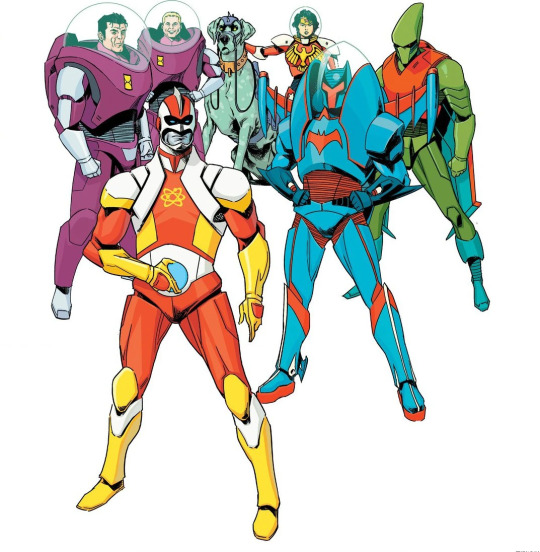
The Atomic Knights of Justice quest across the radioactive landscape of Novamerika in a world decimated by nuclear was in 1963 in search of Earth 15′s Cosmic Grail, their only hope against the coming of Darkseid. A mashup of the Justice League with the protagonists of one of the most fascinatingly bizarre comics of DC’s Silver Age in the Atomic Knights, a mythic quest, and most relevantly “What if Fallout had superheroes?” leaves this feeling like it’s just waiting for its moment to shine.
13. Earth 8 aka Angor
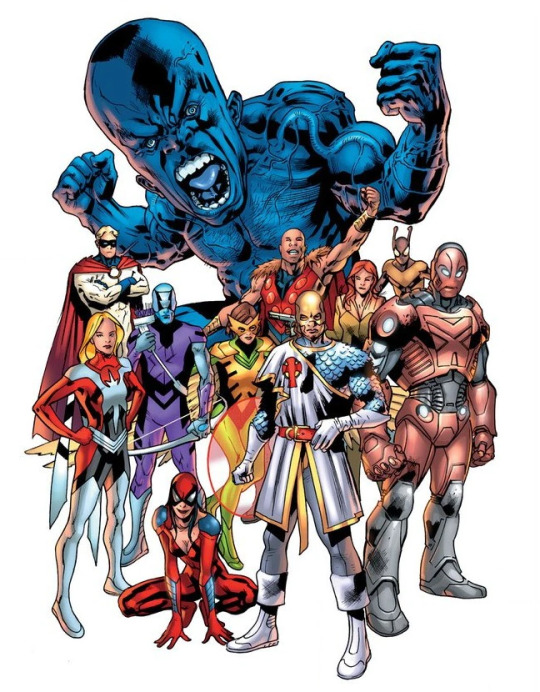
Known across the rest of the multiverse as the protagonists of the Major movies and comics (as opposed to the sub-imprint Essential Major reflecting Earth 7), in actuality the non-actionable champions of Angor - the Retaltiators, the G-Men, the Future Family, and The Bug, among others - are as real as any other superheroes, and while they struggle under the weight of both mistrust by the general public and frequent in-fighting, they’ve thus far protected their world from threats global, universal, and multiversal alike. The Big Two having stand-ins for each other is a longstanding tradition for good reasons: it not only allows for crossovers where the legal stars don’t align (and adds an extra fun shock of recognition whenever the reader realizes what’s happening), but provides each of them an ongoing version of those archetypes to play with within the confines of their own narrative, whether as contrasts or bending them to fit the tone of a very different shared universe than they were originally created for.
12. Earth 16 aka #earthme
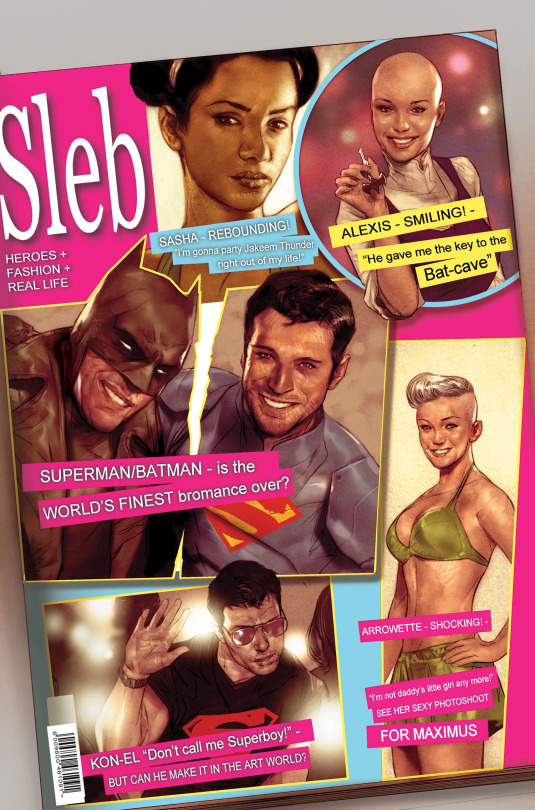
The world where every sidekick, super-son, successor, and short-lived ‘new generation - of HERO!’ at last seize their moment in the sun...in a world already saved by their predecessors, with little left to do but lap up lives of super-celebrity and wish for one, just one little alien invasion or immortal tyrant to justify their existences for them. The best of DC’s futuristic/what-if-time-mattered alternate Earths in my opinion, taking to its logical conclusion the notion as stated by Morrison in interviews that as the Justice League will stick around as long as there are evils that need fighting, the ever-present promise of the torch being passed could only ever truly, permanently take place in a world where the job was already redundant. Playing as it does with in-universe history, real-life publishing realities, celebrity culture, generational divides, and the question of what being a superhero even means sans the usual confrontational justifications, it’s by its nature only going to become more expansive and interesting a commentary as time goes by and the regular DCU goes through its cycles of reboots, rebirths, and returns to form.
11. Pocket Universe 54471
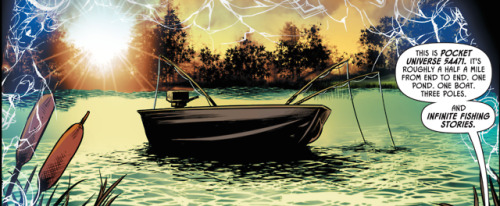
Exactly what you see: Superman made a little pocket universe a half mile wide to go fishing in and he was gonna take Bruce and Dick there for the former’s bachelor party, and he knows about and/or created at least 54470 others. It’s absolutely delightful not only in its own right, but as an opening of the door to what the multiverse can mean in DC comics as a sci-fi idea generator beyond riffs on existing properties, while still being presented with a distinctly DC sense of playfulness.
10. Earth 45 aka Earth 45™

The origin of one of the best Superman villains of all time in Superdoomsday - the Superman idea in a world without him brought to life but twisted by committee into a murderous living brand - a horrifying corporatocracy standing for all Superman and company are meant to stand against, and an enduring threat with the world still in shackles and those in power still able to dream to life whatever vision they please of absolute power to be wielded in their name.
9. Earth 36 aka Terra

Justice 9, the defenders of Terra - or I suppose Justice 7 now after the losses of Optiman and Red Racer, though how long does that matter in a superhero universe? - is the most interesting of the direct analogue groups for my money. Technically speaking they’re another twice-removed set like 34 and 35, standing in for the heroes of Big Bang Comics, but given my understanding is that there’s no major “Like the DC heroes, BUT” twist in that book the way Astro City and Supreme have other than a retro ‘good old days’ bent (which definitely isn’t the case here with at least two queer members), Justice 9 basically function as direct analogues for the Justice League...in the same comics as the Justice League. To me, that’s actually fascinating: one of the most useful elements of stand-in characters like this is the ability to tap into the iconic power of archetypes without the familiarity surrounding the actual figures, in the way Planetary for instance uses just enough distance from the source material to make a couple dozen decades-old pop culture touchstones feel completely new, and this implements that approach to the material to the DC characters with heroes who can actually themselves team up with DC proper. As many approaches as could be taken with that though, that potential alone probably wouldn’t be enough to shoot it this high up the list if not for a major additional factor: in the same way that in the old-school DC universe the heroes of Earth-1 had comics reflecting the adventures of the heroes of Earth-2 long before learning they were real in another universe, DC Comics are published on Earth 36. Aside from the neat trick of putting our leads in the same position as the Golden Age heroes, it means Justice 9 grew up with the Justice League as their heroes in the same way as us the audience before becoming heroes themselves, and then they grew up to learn they were real. These folks absolutely deserve to become multiverse standbys.
8. Earth 51
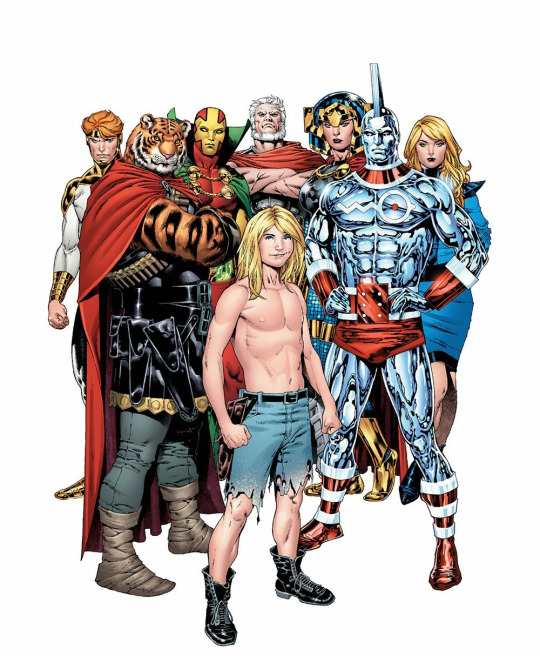
The Earth where all Jack Kirby’s ideas live as a single cohesive world and adventure. No further justification is needed.
7. Earth 13

A world of occult danger where DC’s traditionally superheroic magical figures such as Zatanna and Deadman are given the full Vertigo horror treatment, while the more intimidating and morally dubious figures such as Etrigan and John Constantine get logos and codenames. Not only an expansion but an offputting inversion of one of DC’s most acclaimed corners, this oddball bunch could bounce off of the capes and tights crowd as easily as your Shadowpacts and Justice League Darks, in ways no other team from any corner of the multiverse could.
6. Earth 20

Pulp champions of a 21st century that remains aesthetically moored in the early 20th, of the handful of Earths converting DC standbys into different genre territory in the local 52 the homeworld of the Society of Superheroes hits hardest, given the role the likes of Doc Savage and The Shadow played in that time shaping the conventions of superheroes as we know them. Add the wealth of concepts presented in their oneshot and the decision to hew away from the traditional Justice League riffs of parallel Earths, and of all the truly new worlds introduced in Multiversity, Earth 20 is the one that most feels like it could support an ongoing all its own.
5. Earth 29 aka Htrae

You gotta have Bizarro World. You just gotta.
4. Earth 33 aka Earth Prime

The in-universe representation of our very own pale blue dot. Whether it’s the birthplace of Superboy Prime where assorted DC creators had to deal with a visiting Flash and Superman throughout the 60s and 70s, meta games with the various incarnations of Ultra/Ultraa, a looming threat yet also victim in need of rescue through the eyes of Justice Incarnate, or the unwitting home of the ‘Superman’ or ‘Batman’ of Kurt Busiek’s off-center takes on the characters in Secret Identity and Creature of the Night, over the years DC has shown a decent amount of restraint in not going back to this particular well too often unless someone has a really clever tale to tell, and as a result it has maybe the single best batting average of all the ‘parallel Earths’ that have been regularly returned to by DC over the years. Give yourselves a hand, folks!
3. Earth 5 aka Thunderworld
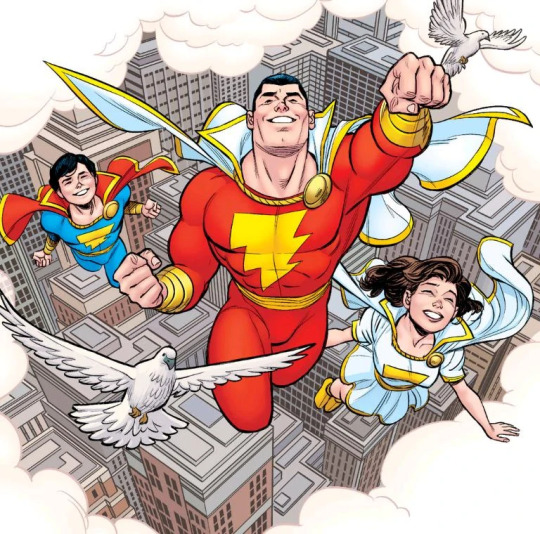
Home not to ‘Shazam’, but Captain Marvel and the Marvel Family in all their glory, a technicolor world playing by the rules set down by Otto Binder and company where a superhero can literally battle planets and the most dangerous villain of all may be a very, very mean worm with glasses, a place of dream logic and childish innocence even by the standards of superhero comics. Captain Marvel at his best is one of DC’s most iconically potent players yet many seem to agree that much of his woes in recent years have come down to trying to find a unique space for him in the DCU proper. While I don’t know that it’s at all impossible to make that work, it’s certainly true that Marvel as he was originally presented doesn’t quite make sense in that world, whereas back in his own he keeps a flavor entirely unique to himself and his partners, whether for solo adventures or teamups with the heroes of the other worlds, playing it straight or examining some of the unsettling implications established by Thunderworld or finding a new way to make it work. Much like Bizarro World, it’s simply a locale the place doesn’t quite feel whole without.
2. Earth 25 (?)

While I’m a bit dubious on it definitely being Earth 25 in the core 52 based on interpretation of an offhanded line from Mr. Terrific (it has a multiverse all its own!), the fact of the matter is that America’s Best Comics came roaring out of the gate as proof of its own title, and basically didn’t stop until it ended. A couple after-the-fact Tom Strong miniseries (containing perhaps the most singularly cowardly hack move in the history of shared universe comics in undoing the end of Promethea) can’t detract from the core ABC lineup being made up of some of the most singularly clever, gorgeous, and heartfelt superhero titles to hit the stands, pretty much the platonic ideal of what you want books like these to look like. If this universe can hang around in any capacity at all until someone god willing picks them up again in a big way, it’s a win in my book.
1. Earth 0 aka Prime Earth

The extant version of the main DCU for at least a little longer, it really does feel like more than just about any version before it - at least for my money - they finally got all their ducks in a row, albeit right before blowing everything to hell. Most of the stories you really want to still have some sort of weight for the major characters are still in play to be built on, and most of the stories that clearly needed to be dropped are dropped. The cosmology’s fleshed out and expanding, the big names mostly work as they should ideally work while still heading into new territory, the JSA is mysteriously somehow around in the past without interfering with the primacy of Superman and the Justice League as the first known superheroes (a mystery that will never be resolved now due to the current reboot; damn shame) and the Legion of Superheroes have a new coat of paint, and there’s room for stories cosmically massive and intimately personal and utterly bizarre throughout the line rather than there being a single overriding idea of what these books should be. It may not be the perfect DC Universe by any means, but it’s a real, real damn good one, and of course without that thing, none of the rest of these universes would have been there in the first place.
81 notes
·
View notes
Text
A Journey to France to Uncover the Mysteries of the Carnegie’s Grand Staircase
The Carnegie Institute has been in existence for 125 years and is one of the greatest architectural buildings ever designed in Pittsburgh. In 1985, Carnegie Institute President Robert Wilburn invited Dr. Cynthia R. Field, the Smithsonian’s Architecture Historian, to assess the artistic value of the museum. He asked, “what do you think is the most valuable specimen or painting in the museum?” She said, “The Building Itself is the Greatest Object of the entire Museum Collection” (Fig. 1).
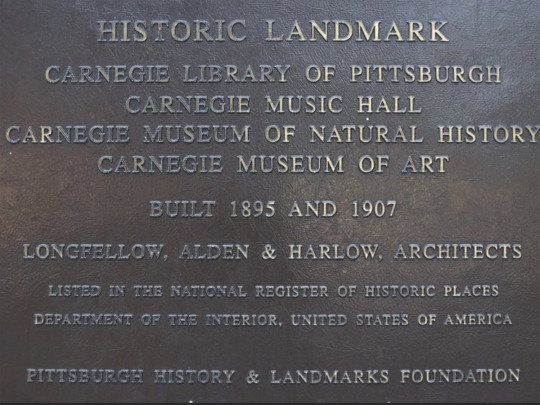
Fig. 1: Carnegie plaque
The internationally-famous architect, I.M. Pei, who designed the Louvre’s glass pyramid that sits in the Louvre’s central courtyard in Paris, France, opined, “Architecture is the very mirror of life. You only have to cast your eyes on buildings to feel the presence of the past, the spirit of a place; they are the reflection of society.” In 2018, Architecture Digest ranked the Carnegie’s Grand Staircase the 8th best museum staircase in the world. The Grand Staircase was built by the Pittsburgh architectural firm of Alden and Harlow at the apex of America’s Gilded-Age building boom. During my research, I discovered that the architects employed multicolored classic marbles and fossil limestones in the interior design from Algeria, Croatia, Greece, France, Ireland, Italy, and the United States. The commission to build the Grand Staircase in 1907 incorporated two classical French fossil limestones in the columns and pillars, floor tiles, steps, walls, balconies, and water fountains. This monumental Beaux-Arts style staircase is modeled after the L‘Opéra Garnier ‛a Paris, Grand Staircase in France, c. 1875, and was visited by a French Delegation with Andrew Carnegie (Fig. 2). The architecture described as Beaux-Arts was taught at the École des Beaux-Arts in Paris, from the mid-19th century until 1900. It drew upon the principles of French neoclassicism and used modern building materials, i.e., iron and glass. And as such, it became a preferred architectural style in the United States from 1895 until 1910 in cities such as, Boston, Chicago, New York City, Pittsburgh, and Washington D.C.

Fig. 2: French delegation and Andrew Carnegie
In 2019, The Carnegie’s Grand Staircase and Music Hall Foyer were recognized in the book La pierre de l’Échaillon Une histoire locale, une renommée international for the use of Échaillon jaune (yellow) ornamental stone in the museum’s columns, pillars, and walls (Fig. 3). This book was published by S.P.I.A. (Sauvegarde du Partrimoine Industriel d’Autrefois, a historical society founded by Jean Paul Rey, president) (Fig. 4). In the book, they describe how a small French village of l’Échaillon, pronounced Esh-ee-own, received recognition for its white marble (a limestone) used by famous French architects in 64 classic buildings and sculptures from 1875 to the early 20th century (Fig. 5). I first met Jean Paul in October of 2016, when I was invited to give a presentation at an S.P.I.A. meeting on my research on the Carnegie’s l’Échaillon. The meeting was held in an old schoolhouse in the village of Saint-Quentin-sur-Isère, Département de Isère, in southeast France.
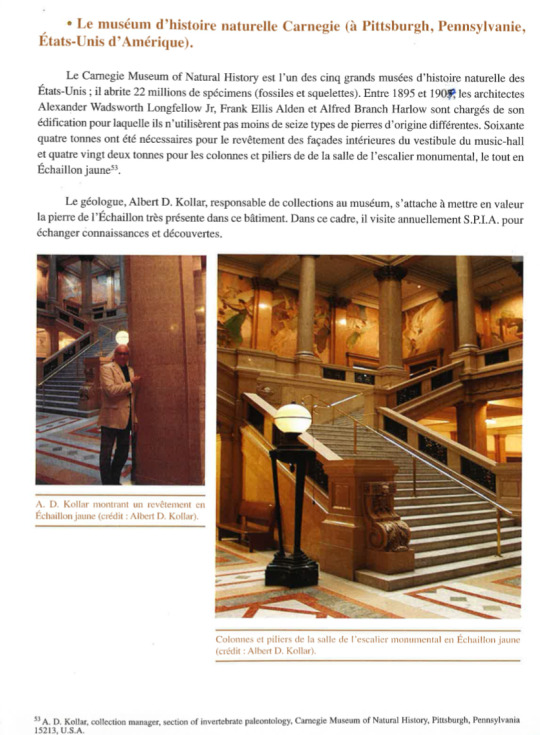
Fig. 3: The Grand Staircase

Fig. 4: Jean Paul Rey and Albert D. Kollar
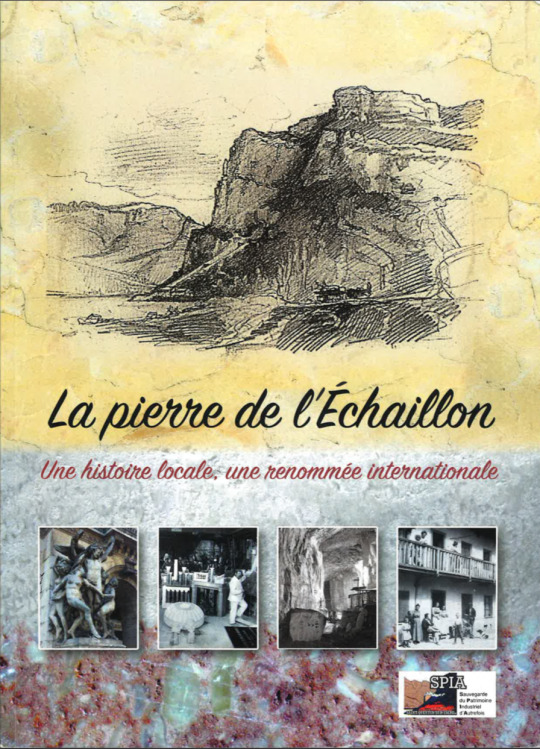
Fig. 5: Book cover
The French Limestones in the Carnegie’s Architecture
The Carnegie building stones research project progressed significantly, once we obtained the digital images of the architect’s blueprints from the Carnegie Museum of Art’s Architecture Department. With the assistance of my co-authors, Rich Fedosick and Kay Hughes of the Section of Invertebrate Paleontology, we examined the blueprints to understand the architects Marble Index terminology (Fig. 6). Eventually, we were able to interpret and recognize the location of the two French limestones based on the Marble Index letters, E for Échaillon and H for Hauteville. From a nonscientific perspective, the architects considered the Carnegie’s interior stones to be marbles. However, the geological definition of a marble is when a rock defined as a limestone or dolomite is subjected to high heat and pressure from geologic forces forms a metamorphic rock. The six stones listed in the Marble Index as marbles, are limestones, a sedimentary rock enriched with fossil seashells. The characteristic rudist fossils and yellow color that distinguish the Échaillon stone are found in the 18 pillars and the 22 columns that rise 3.8 meters or 12.5 feet about the Grand Staircase, and in the walls of the Music Hall Foyer (Fig. 7).
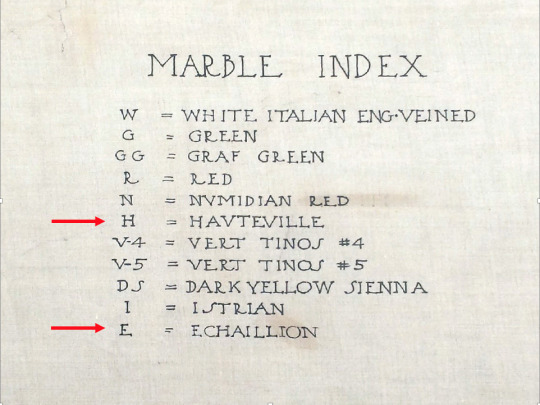
Fig. 6: Marble index E and H letters

Fig. 7: Échaillon fossils
The other French limestone used in the Carnegie is Hauteville. This limestone was quarried from the Plateau d’Hauteville in the Ain Department, in eastern France. I visited this quarry in 2016 to investigate the geology of the quarry operation, to uncover evidence of the common fossil snail Nerinea in the quarry rock (Fig. 8), and to learn more about the cultural history of the region (Fig. 9). The Hauteville limestone was used in the Grand Staircase walls, balcony features, water fountains, vestibule steps, and as floor tiles. Other locations include, the Hall of Sculpture and Hall of Architecture floors, the walls along the grand hallway, the Music Hall vestibule floor, the Founder’s Room vestibule floor, the floor and steps in the Smoking Room (now offices), the Forbes Avenue vestibule entrances to the music hall, carriage drive, and museum and fine arts. Moreover, the Hauteville floor tiles are distributed throughout the Carnegie Library of Pittsburgh main entrance corridors. The Hauteville stone is beige in color and contains many visible fossils, none more distinctive than the robust Nerinea, a 12.7 cm/5-inch-long snail that serves as the index fossil for the limestone identification (Fig. 10).

Fig. 8: Hauteville Quarry fossil snail

Fig. 9: Hauteville directional signs

Fig. 10: Nerinea snail in Carnegie floor
Introduction to the l’Échaillon Carrières
There are three carrières or quarries in the Vercors cliffs located in the Isère River Valley that were excavated for White Echaillon or “Echaillon blanc,” Yellow Echaillon or “Echaillon jaune,” and Pink Echaillon or “Echaillon rose” during the 19th and early 20th century (Fig. 11). These unique color combinations became popular for various interior and exterior architecture features in 194 buildings in western Europe, North Africa, and the United States. In 2016, Jean Paul Rey and members of S.P.I.A. led me on a field trip to the abandoned classic l’Échaillon white quarries (Fig. 12). We explored what is thought to be a 2,000-year-old Roman quarry and walked through a maze of underground caverns and narrow tunnels that contained abandoned mining equipment. The other two Echaillon carrières are located several kilometers south in the small villages of Lignet, where the Pink Echaillon was quarried (Fig. 13) and Rovon, where the Yellow Echaillon was excavated (Fig. 14).

Fig. 11: Echaillon quarries locations, S.P.I.A.
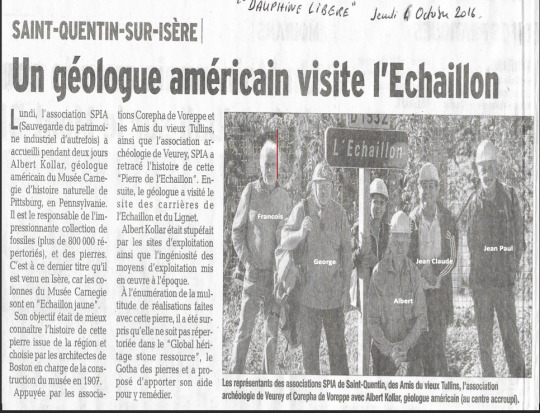
Fig. 12: Visit to Echaillon

Fig. 13: Lignet Quarry Marker

Fig. 14: Rovon quarry
Cularo, Grenoble, and the white l’Echaillon stone
A fortuitous discovery was made by S.P.I.A. for their book while searching for evidence of the white l’Echaillon in the Gallo-Romans era 4th century Cularo or Grenoble, France today. In the Saint Laurent crypt that is preserved many meters below the modern-day street level tramway, a white capitol on top of a white limestone column was identified as l’Echaillon. This white capitol stone is presumably from the Roman quarry adjacent to the white l’Echaillon underground caverns. When Emperor Gratian ruled the Roman Empire from 367 to 383 A.D., he renamed Cularo after himself. Cularo thus became Gratianopolis, which through a later phonetic shift became Graignovol and then Grenoble. Although hard to find among the narrow streets and passageways of Grenoble, is a section of a Roman wall that once encircled Cularo, a portion of which is protected by a fence. This historic wall can be seen at Passage Sainte-Claire on the corner of Rue Lafayette, in the central city of Grenoble (Fig. 15). I suspect some of the white cobbles embedded in the wall may have their origin from the white l’Echaillon Roman quarry. Undoubtedly, more research will be necessary to make an affirmative conclusion.

Fig. 15: Roman wall
“Geology of the l’Échaillon Carrières”
The drawing of a new geologic map on the l’Echaillon carrières by Professor Thierry Dumont of the Université Grenoble-Alpes, confirms stratigraphically, the ages of the three limestone quarries. Among the three, the white Echaillon limestone is late Jurassic in age, whereas the pink Lignet and yellow Rovon limestones are early Cretaceous in age. The formal geologic name for the rose and yellow limestones is the Urgonian Formation. Fossils are abundant in the three limestones. Dr. Claudie Durand of Le musèum d’Histoire naturelle de Grenoble (Fig. 16) curated a diverse collection of 163 species of invertebrate fossils from l’Echaillon first published in 1919. Geologically, the three limestones were deposited in the tropical Tethys Seaway a circum-equatorial ocean of the Mesozoic Era. The strata form the Vercors carbonate platform, a buildup of late Mesozoic rudist (bivalve mollusk) reefs spanning 25 million years of evolution from (late Jurassic 140 million years ago to early Cretaceous 165 million years ago) (Fig. 17).

Fig. 16: Dr. Claudie Durand

Fig. 17: Rudist (bivalve) reef fossils
The Rovon carrière provenance and fossils
The primary goal of this research is to define the geology and authenticate the specific provenance of all marbles, fossil limestones, sandstones, and the singular igneous granite rock used in the Carnegie building. The search for the provenance of the Carnegie’s yellow Echaillon was initiated in December of 2017 by Jean Paul Rey, when we were introduced to the Forman of the modern-day Rovon quarry. After a long discussion about our objectives, he granted permission to visit the old quarry. As darkness fell, we met with a local farmer who directed us to the quarry location in the Vercors cliffs that rise some 538 meters above his snow-covered field (Fig. 18).

Fig. 18: Verors cliffs and old Rovon quarry
In October of 2018, the S.P.I.A. team pre-arranged to have several 4-wheel trucks transport ten people including Professor Fabienne Giraud-Guillot of the Université Grenoble-Alpes to the Rovon quarry. We ascended the long steep road that ended some 500 m from the main quarry. Surprisingly, the quarry was filled with massive limestone boulders that were cut by mechanical wire saws from the cliff rock (Fig. 19). Such large boulders make it virtually impossible to break with small hammers. For actual fossil collecting purposes, it is better to search for smaller size rocks to break apart (Fig. 20). This past October, transport to the Rovon quarry riding in a 55-year-old Russian built farm tractor was a treat (Fig. 21). And the fossil collecting was a success with 21 complete specimens collected for the museum of the diagnostic Caprina rudist bivalve clam (Fig. 22). The shape of these fossils closely resembles the fossils preserved in the Echaillon limestone in the Grand Staircase and Music Hall Foyer. Additional geologic data is being reviewed by colleagues from the Geology Department at the University of Zagreb in Croatia and the University of Ireland at Galway.

Fig. 19: S.P.I.A. team

Fig. 20: Collecting fossils

Fig. 21: Russian tractor

Fig. 22: Caprina rudist clam
“Carnegie’s Grand Staircase in the 21st Century”
A study published this month by the BMJ, formerly The British Medical Journal, suggested that “when people of all ages participate in the arts and visit museums once a month or even every few months, they are likely to be more engaged in the world and may actually live longer.” Years ago, the Oscar winner actor Russell Crowe was in Pittsburgh, and he was asked what he did on his days off. In reply, he said, “I ride my bicycle to look at buildings and the architecture of the city.” I. M. Pei states, “Architecture brings people together.” I agree.
Maybe it’s time to reconsider how the Carnegie’s Grand Staircase is promoted to the public at large. For instance, the current arrangement of the free-standing dioramas situated on the first floor, awkwardly impede the flow of patrons walking among the pillars, columns, and the taking of photographs of the Grand Staircase. Moreover, the placement of these dioramas detracts from the visual enjoyment of the famous John White Alexander multicolor murals. An artistic feature of the murals is their connection to the stone colors to enhance the first and second floors architectural features. The best vantage points to see this fabulous spectrum of color is from the third-floor balcony looking down to the first and second floors.
The Carnegie Museum of Art (Museum of Fine Arts) will be celebrating its 125th Anniversary in the fall of 2020. The Grand Staircase was designed as the showcase entrance to the Museum of Fine Arts for Pittsburghers of the early 20th Century. One hundred and twenty-five years later, perhaps, this world-class space can once again establish a new generation of museum patrons and become the destination as a place to be for its cultural and intellectual heritage. And don’t forget, this staircase can be an Instagram-worthy site for a family portrait to encourage our younger audiences to visit too.
Albert D. Kollar is the Collection Manager in the Section of Invertebrate Paleontology at Carnegie Museum of Natural History. Museum employees are encouraged to blog about their unique experiences and knowledge gained from working at the museum.
88 notes
·
View notes
Text
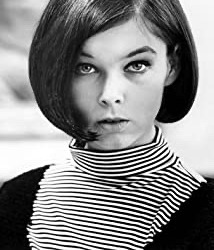
Yvonne Joyce Craig (May 16, 1937 – August 17, 2015) was an American ballet dancer and actress best known for her role as Batgirl in the 1960s television series Batman and as the green-skinned Orion slave girl Marta in the Star Trek episode "Whom Gods Destroy" (1969). The Huffington Post called her "a pioneer of female superheroes" for television.
Yvonne Craig was born in Taylorville, Illinois, and was raised in Columbus, Ohio. In 1951, her family moved to the Oak Cliff neighborhood in Dallas, Texas, where she attended W. H. Adamson High School and then Sunset High School, from which she did not graduate due to the lack of "a single PE credit".
After being discovered by Alexandra Danilova, a ballerina and instructor, Craig joined the Ballet Russe de Monte Carlo as its youngest corps de ballet member. This training was helpful when she performed stunts while playing Batgirl.[6] She left the ballet company in 1957 "over a disagreement on casting changes" and moved to Los Angeles in the hopes of continuing her dancing career but found herself cast in film roles.
Acting Edit
One of her earliest television roles was in an episode of the TV series Perry Mason ("The Case of the Lazy Lover", 1958) alongside Neil Hamilton, who played her stepfather (later Hamilton played Police Commissioner James Gordon, Batgirl's father). Shortly afterwards, she appeared in three films—The Young Land, The Gene Krupa Story and Gidget (all 1959)—and also guest-starred in the TV series Mr. Lucky as Beverly Mills in the episode "Little Miss Wow" (also 1959). Craig appeared with Bing Crosby in High Time (1960) and in Seven Women from Hell (1961) featured alongside Cesar Romero. In 1962, she guest starred on the Western Laramie in the episode "The Long Road Back".
Craig starred in roles with Elvis Presley in two films: It Happened at the World's Fair (1963) and Kissin' Cousins (1964). She also starred in the cult sci-fi film Mars Needs Women (1966) and appeared in In Like Flint (1967) as a Russian ballet dancer opposite James Coburn.
During the 1960s, Craig regularly appeared in television drama series. She appeared five times on The Many Loves of Dobie Gillis, portraying five separate girlfriends for the titular character between 1959 and 1962. In 1960, she played Jo, a young photographer with Charles Bronson in Man with a Camera. In 1964, Craig guest-starred as Carol, an underwater photographer, on Voyage to the Bottom of the Sea (episode "Turn Back the Clock").[9] In 1965, Craig appeared in The Big Valley (episode "The Invaders"). Craig also appeared on Star Trek as Marta, a green-skinned Orion slave girl in the episode "Whom Gods Destroy" (1969).
Craig played a Navy nurse with exotic Arabian dance skills in an episode of McHale's Navy ("Pumpkin Takes Over") as well as in an episode of The Big Valley with Lee Majors and Barbara Stanwyck both aired in 1965. That same year, she appeared in an episode of The Man from U.N.C.L.E. ("The Brain-Killer Affair"), where she helps solve the mystery of a brain-endangering poison.[10] The following year she came back as an U.N.C.L.E. employee in a theatrical film, One Spy Too Many expanded from the episode "The Alexander the Greater Affair". In an episode of The Wild Wild West ("The Night of the Grand Emir") in 1966, she played an assassin who performs an exotic Arabian dance. In a 1968 episode of The Ghost & Mrs. Muir ("Haunted Honeymoon"), she played Gladys Zimmerman, a bride-to-be who was stranded overnight at Gull Cottage. In a 1970 episode of Land of the Giants ("Wild Journey"), she played one-half of a humanoid, time-observing duo (alongside Bruce Dern) who chase two of the Earth castaways (the series stars Gary Conway and Don Marshall) into the past, ultimately forcing them to relive the flight that sent them to the giants' planet.
From September 1967 until March 1968, Craig appeared in her highest-profile role as Batgirl for the third and final season of the 1960s ABC TV series Batman. As Batgirl, she wore a purple and yellow outfit and rode a "purple motorcycle with white lace trim",[6] whereas her alter ego Barbara Gordon was the librarian daughter of Commissioner Gordon.[12] The New York Times praised her for "add[ing] a scrappy girl-power element" to a TV series it described as "campy".
During this time, Craig appeared as a contestant on the game show The Dating Game (1967).
Craig reprised her Batgirl role in a 1974 public service announcement for equal pay for women sponsored by the U.S. Department of Labor Wage & Hour Division. In the PSA, Batman and Robin were tied to a post amid the threat of a ticking time bomb, but Batgirl refused to release them because she was paid less than Robin, in violation of the Federal Equal Pay Law. The PSA was written and directed by Sidney Galanty, and narrated by William Dozier, who had narrated the Batman TV series. Dick Gautier played Batman this time, because Adam West was, at the time, trying to distance himself from that role.
Craig reportedly felt some connection to the character and was sad that Barbara Gordon was shot and paralyzed by the Joker in the graphic novel Batman: The Killing Joke (1988).
After Batman, Craig continued to act sporadically in movies and television. She appeared in guest roles in Kentucky Jones, It Takes a Thief, The Mod Squad, Mannix and Emergency!. From 1969 to 1972, she appeared in four episodes of the comedy series Love, American Style. In 1973, she appeared in a first-season episode of Kojak ("Dark Sunday") and in 1977, she made a guest appearance in The Six Million Dollar Man ("The Infiltrators").
When her Hollywood career ended, she ventured into private business. She was briefly a co-producer of industrial shows, before starting a new career as a real estate broker. From 2009 to 2011, she voiced "Grandma" on the animated children's series Olivia. Craig published an autobiography called From Ballet to the Batcave and Beyond (2000). She appeared in the documentary film Ballets Russes (2005).
She was also a philanthropist and advocate for workers unions, free mammograms, and equal pay for women.
Craig died at age 78 at her home in Pacific Palisades, Los Angeles, California, on August 17, 2015, from metastatic breast cancer that had spread to her liver.
7 notes
·
View notes
Text
Shadow Over Seventh Heaven Review, Part I: Last Night I Dreamt I Went to Maljardin Again

Once, April Tennant had been the greatest screen star of all. Even now that this stunning creature was gone, the victim of a hideous accident, her name still cast a magic glow. And nowhere was her haunting spell more alive than within her great walled estate of San Rafael.
It was here that April had lived in her storybook marriage with famed actor Richard Morgan. It was here that her memory was worshipped still. And it was here that lovely young Jenny Summers came as Richard Morgan's new bride--to discover the terror behind the tinsel in this place transformed from a paradise of the living to a hell of the undead.... (inside front cover)
Welcome, fellow Strangers and all others who happen upon this post. This week, I have decided to begin a new series exploring the Gothic novels written by co-creator and first headwriter of Strange Paradise, Ian Martin, under the pen name Joen Arliss. Mostly, the purpose of this series will be to compare the plot and characters of Strange Paradise and those of his novels and what that may indicate about his original intentions for the overarching story of the soap opera.
I got the idea to start this series while writing my review of Episode 26, after the contents of an article referenced in one of the scenes reminded me of the events in this book. On his now-defunct website Maljardin.com, Curt Ladnier covered some of the similarities between “Here Goes the Bride,” the CBS Radio Mystery Theater drama from which this book was adapted, and Strange Paradise, but I wanted to dive deeper and do one of my characteristic overanalyses. So fly with me to the grand southwestern estate of San Rafael and together let’s explore Shadow Over Seventh Heaven--and let me warn you, there will be spoilers for the entire Maljardin arc of SP.
As noted above, Shadow Over Seventh Heaven is an adaptation of a radio drama that Martin wrote for CBS Radio Mystery Theater. CBSRMT is, perhaps unquestionably, Ian Martin’s most famous work. Created by Himan Brown in 1974 and running for 1,399 nightly episodes, Martin wrote a total of 243 (including many adaptations of literary classics) and acted in 255, typically in supporting roles. He continued writing and acting on the series all the way until his death in 1981 at the age of 69. Given my tendency to procrastinate, which sometimes makes it difficult to write just one episode review a week even when I’m not busy, I envy him for being such a prolific writer. I suspect that all the soap scripts he wrote got him into the habit, and he just couldn’t break it.
Even more extraordinary is that he wrote and published five novels during the same period that he worked on CBSRMT. His first was Nightmare’s Nest (1979), an adaptation of the CBSRMT play “The Deathly White Man” (and not the other drama, also by him, of the same name), which is his answer to Jane Eyre and which also has some interesting connections with SP which I plan to explore in another review series. Next came this novel, and then Beloved Victim (1981), adapted from “A Lady Never Loses Her Head,” which I don’t recall having anything noteworthy in common with SP, but I may need to re-read it to make sure. He also wrote two mystery novels, The Shark Bait Affair and The Ladykiller Affair, for the Zebra Mystery Puzzler series, but those are both very rare now and I haven’t yet read either, so I can’t say anything about them. The book Mystery Women: An Encyclopedia of Leading Women Characters in Mystery Fiction does, however, provide some information on their protagonist, Kate Graham, along with short plot summaries. As someone with two trunk novels from the last decade and about fifty pages of a third--which I mostly stopped working on after I started this blog--I also envy him for this. How on Earth did he find the time?
But I digress. Like that of “Here Goes the Bride,” the plot of Shadow Over Seventh Heaven draws heavy inspiration from Daphne du Maurier’s famous Gothic romance Rebecca, but with some major differences in plot and characterization. The novel fleshes out the radio drama some more, adding additional details and plot twists that aren’t present in the original play, which arguably make it more interesting. One gets the impression that he had a lot of story in mind while he penned the original drama, but knew he could only squeeze so much into a 45-minute radio play and so had to leave many of the most interesting details out.
But that’s enough background information. Let’s begin our analysis and see what Ian Martin’s later work can tell us about his original intentions for Strange Paradise.
Introduction
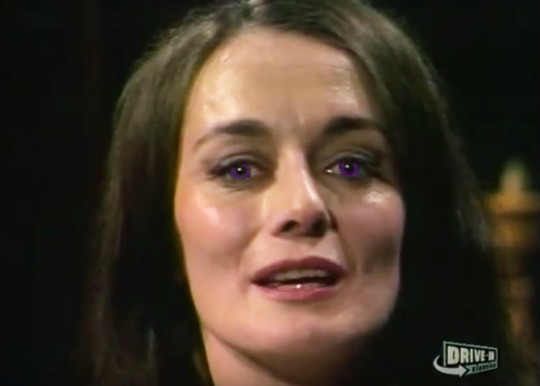
The face is lovely, matchless....
Opening like some gigantic and exotic flower as the camera zooms in...
It fills the screen, flawless, enticing....
The lower lip glistens, pulled away from those perfect teeth, trembling ever so slightly, promising undreamed-of delights for the man brave enough to taste its forbidden fruit....
The skin glows with an inner light....
The eyes beyond the thick fringe of dark eyelashes shimmer with the deep violet of a tropical night....
The pitiless exposé of the camera is defeated, no matter how close it probes in close-up....
This is beauty without blemish....
This is everyman's dream woman--sex symbol of the nation, and most of the world....
This is April Tennant!
Strange to think of her dead, for on the screen she is captured forever in all her vibrancy and stunning beauty....
Impossible to think of her lying, mangled and bleeding on the rocks, while the hungry sea licks out as if to possess her.
Incredible to think of her cold and in the grave. Which she has been for twelve months--or this story never would have begun (p. 5).
The first page of the novel introduces us to April Tennant, this novel’s Rebecca and also its Erica Desmond. Like Rebecca, she is the first wife of the protagonist’s love interest, whose tragic death will cast a shadow over her former estate. Like Erica, she was a famous actress--probably more so than Erica ever was--but the cause of her death is not the same as the alleged cause of Erica’s. In Episode 5 of Strange Paradise, Erica’s grieving husband Jean Paul claims that she died of eclampsia while pregnant with their son, although evidence uncovered by other characters in later episodes leads them to contest that claim. Instead, April’s death resembles that of Huaco, the wife of Jean Paul’s ancestor Jacques Eloi des Mondes who died when she fell from a cliff on Maljardin, Jacques’ island estate.
In this introduction, we also see what will become a theme of the novel: gaze. Not just the male gaze--the obvious POV of the introduction--but, more generally, the viewing of April Tennant almost exclusively through the eyes of other characters, both male and female. We never learn much about her inner life, even as we learn those of Jenny (our protagonist), Richard, and others. April is largely a mystery, a larger-than-life figure of ideal beauty who, in the eyes of the public, is more a legend than she is flesh and blood. It’s the same mystique that surrounds celebrities in real life that often makes other people forget that they, too, are human--if, indeed, that’s what April was. Or is there more to it? I guess we’ll have to find it.
Chapter 1
The first chapter begins with a detailed description of San Rafael--and by detailed, I mean that Ian Martin spends one and a half pages describing its wall, followed by two on the mansion itself. I won’t type out too many passages from this book for copyright reasons--for, unlike Strange Paradise, this book is still under copyright--but I will include some highlights. The wall surrounding the castle “was thick enough at the bottom to withstand any tremor of the California earth...topped by a corona of jagged broken glass and it ran for a mile and three-quarters in a great semicircle away from the rocky Pacific coast and back to it again” (p. 6). On its gate,
The ironwork swept and swirled in great balanced curlicues, and the frame was heavy and studded. The studs held great sheets of blackened steel, heavy enough to withstand a battering ram, blocking any vision of the grounds the wall concealed. And the vertical members of the scrollwork reared high above the frame of the door and the top of the wall in a bristling array of spikes, sharp as swords, arched forward to further discourage any hardy trespasser who might try to climb their height (pp. 6-7).
In case you haven’t already figured it out, Martin loved his purple prose. If you don’t like Byzantine descriptions of architecture, ironwork, clothing, or anything else, you probably shouldn’t read this book or any of Martin’s other novels. (Nightmare’s Nest is far purpler, however, than this one. There’s an entire chapter in there devoted to describing the protagonist’s lush Edwardian finery.) Fortunately for me, I love this kind of thing and will gladly devour description after description of gates covered in iron curlicues. My literary tastes tend toward “more is more” and I’m not ashamed to admit it.
We learn that San Rafael is a reconstruction of an old Spanish mission, commissioned by April and built in part by Richard himself, “who personally took charge of putting in all the glass that fronted on the sea.” The gardens that surround it give it “a riot of color--bougainvillea, hibiscus, passionflowers, trumpet vines--all enhanced and set off against the majesty of rows of carefully spaced Italian cedar, or Lombardy poplar” (pp. 7-8).
Despite all this radiant beauty--and as one might expect for reconstructed ruins from the era of Spanish colonialism--the estate is believed to be cursed, at least by “the superstitious peons who built the walls” (p. 9). (That’s what the book uncharitably describes the Mexican builders--some parts of this book haven’t aged well, as you will see.) Two men died while rebuilding it, followed by April herself around a decade later.
Surprisingly, we learn at the end of this chapter that Richard Morgan’s background differs from that of Jean Paul Desmond. An actor himself, he “was king of the theater, and of East Coast entertainment. Their marriage was a royal one, and it vaulted both of them to new and undreamed-of heights of popularity” (pp. 9-10). It was this popularity that drove them to wall themselves in at San Rafael and use the police and guard dogs to keep rabid fans and paparazzi away--which, ultimately, didn’t work and only led to “a new wave of interest and snooping” (p. 10).
Chapter 2
Here we meet Richard’s sister Lisa, who is...well...quite an interesting character. She’s a beautiful woman with short hair, a deep voice, and--most importantly--an unusual, creepy level of attachment to her brother.
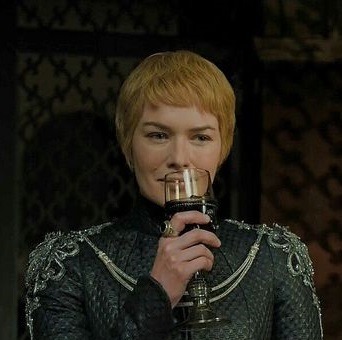
Cersei Lannister Lisa Morgan.
Lisa has just received a phone call from the Philippines where her brother is. The call has left her “literally stunned” (p. 11), which means that the modern slang meaning of “literally” dates back 30+ years longer than I thought. Surprisingly, she isn’t drinking wine to calm her nerves like Cersei above, but that’s her loss.
As she gazes at the ocean to the west, her housekeeper, Conchita Aguilar, enters. Chita (as she is usually called) has not just worked as April’s housekeeper for most of her life, but also "she and her husband, Juan, had quite literally brought up April” (p. 13); as a result, she is fiercely loyal to the family of her deceased mistress. Here is a portrait of her:
Looking at the tiny woman with her bright button eyes, the black Indian hair swept stiffly away from her face, parted in the middle and tidily put away in a tight bun low on the back of her neck, Lisa was surprised at the sudden urge to go and take this familiar person in her arms--or better still have Chita take her in hers.[...]Chita might be tiny, but she was all steel and whipcord (p. 13).
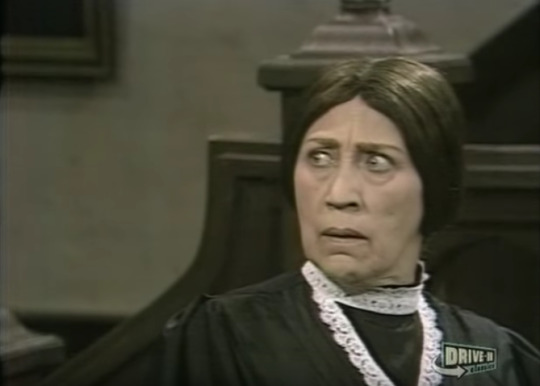
Sound familiar?
Yes, Chita bears a resemblance to our beloved Raxl. They even have a similar background, for Raxl, too, comes from a people indigenous to Mexico, according to Episode 23. Like Raxl, Chita is very old and has a mysterious magnetism that draws some people to her (which, in Raxl’s case, includes me). There are some minor differences--Chita doesn’t worship the Great Serpent, she uses gratuitous Spanish instead of gratuitous French, she has a living husband and grandson--but they are, in most ways, the same character. It’s clear that Ian Martin didn’t want to part with Raxl, and I don’t blame him one bit.
Also, for whatever reason, he was oddly insistent on both of them having a specific hairstyle. If you read the original script for the show’s pilot, you will see that he was almost as specific about Raxl’s hairstyle, mentioning “her hair tightly drawn over her ears to a small bun,” but less detailed about those of the other characters. Just an odd detail that probably bears little significance, but that I noticed.
Lisa tells Chita that Richard is on his way home with a new wife, a young, very wealthy orphan named Jenny Summers whom he met in the Philippines. This angers the ancient housekeeper, who argues that Jenny can never come to San Rafael
Because there is no place for her here--en la casa de La Señora! Everything here is hers--she still lives here, and will always live here. Her perfume is in every room, her pictures are everywhere, every ornament and ashtray and book I keep just the way she last touched it. There is no room for any other wife here! Oh, she will feel it, she will know it, because La Señora would never permit another woman to take her place (p. 16)!
Lisa insists that, despite the risk that Jenny won’t want to live on the estate and despite her equal displeasure about the situation, Chita keep an open mind regarding her and try not to be such a Mrs. Danvers about the situation. (OK, so she doesn’t actually say the last part; that’s just my paraphrase.) She also tries to pressure Chita into helping her take down the mementos of April at Richard’s orders, which she objects to, both for sentimental reasons and because they don’t have time to have the enormous fresco of April that adorns the former chapel. (Symbolism!)
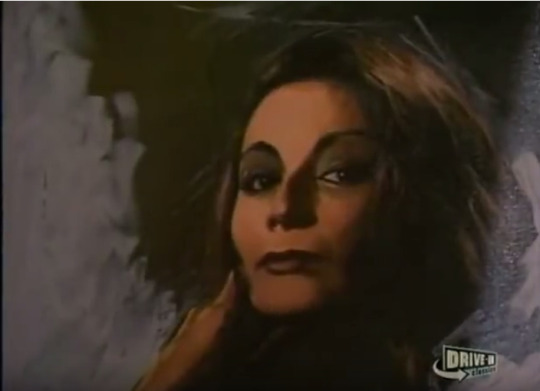
“It was a breathless and yet terrible beauty. For any woman who stood next to it had to be eclipsed” (p. 20).
Yes, you read that right: they rededicated the mission’s former chapel to the silver screen sex goddess April Tennant. After their wedding, Richard had a giant fresco of her painted there in place of its former altar. This is a clear indication that one or more of the people in this household worship April, whether literally or figuratively. More than that, the portrait glows like that of THE DEVIL JACQUES ELOI DES MONDES, and seems, like Jacques’ portrait, to be alive, the living essence of a dead person. “Most haunting of all was the feeling that this was the woman--that she could not have died, that any moment she would step off the wall, and her silver laughter would fill the house again (p. 20).”
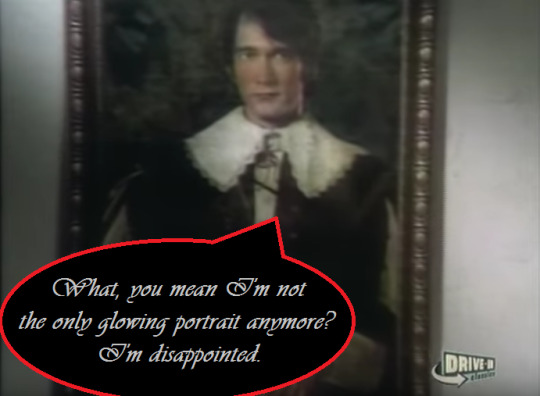
I’m sorry, Jacques. ;)
Coming up next: Jenny arrives at San Rafael and tries to adjust to living on an estate where almost everyone but Richard acts like they hate her.
{ Next: Part II -> }
#gothic fiction#cbs radio mystery theater#ian martin#joen arliss#shadow over seventh heaven#cbsrmt#strange paradise#related media#review#other reviews#ian martin's novels#analysis#gaze#rebecca#speculation on ian martin's original story#symbolism
5 notes
·
View notes
Text
Otis Blackwell

Otis Blackwell (February 16, 1931 – May 6, 2002) was an American songwriter, singer, and pianist, whose work influenced rock and roll. His compositions include "Fever", recorded by Little Willie John; "Great Balls of Fire" and "Breathless", recorded by Jerry Lee Lewis; "Don't Be Cruel", "All Shook Up" and "Return to Sender" (with Winfield Scott), recorded by Elvis Presley; and "Handy Man", recorded by Jimmy Jones.
Biography
Blackwell was born in Brooklyn, New York. He learned to play the piano as a child and grew up listening to both R&B and country music.
His first success was winning a local talent contest ("Amateur Night") at the Apollo Theater, in Harlem, in 1952. This led to a recording contract with RCA and then with Jay-Dee. His first release was his own composition "Daddy Rolling Stone", which became a favorite in Jamaica, where it was recorded by Derek Martin. The song later became part of the Who's mod repertoire. Enjoying some early recording and performing success, he found his first love was songwriting and by 1955 had settled into the groove that he would ride for decades. His first successes as a songwriter came in 1956, when Little Willie John's R&B hit with the sultry "Fever" was an even bigger pop success for Peggy Lee, and "Don't Be Cruel" began a highly profitable association with Elvis Presley.
Blackwell was one of the leading African-American figures of early rock and roll, although he was not well known by the public. His own records never cracked the Top 40, yet he wrote million-selling songs for Elvis Presley, Jerry Lee Lewis, Dee Clark and others. He also recruited other songwriters to write for Presley, such as Winfield Scott.
In the liner notes of Elvis' Golden Records (1958), Anne Fulchino, of RCA, wrote,
While sipping coffee, Steve Sholes pulled out a demonstration record of 'Don't Be Cruel' and told Elvis it was a new song written by Otis Blackwell, whom Elvis had long admired as a rhythm and blues artist. It took just a few bars to convince Presley that it was a perfect song for him, and he decided to cut it right away. Presley learned the song within minutes—he had an inherent musical sense—and in short order a great master was put on tape.It isn't often that the title of a song will create a whole new expression in Americana. 'All Shook Up' did exactly that. Youngsters and adults alike have made the phrase a common part of everyday usage. The background to the song itself is a rather interesting one. Since the huge success of 'Don't Be Cruel', Elvis had been anxious to record another song from the pen of Otis Blackwell. Eventually, Blackwell came around with 'All Shook Up' (first recorded by David Hill on Aladdin). Presley wasn't completely satisfied with the song, and with Blackwell's consent re-wrote part of the lyrics. Thus, as co-writer as well as artist, Presley produced his ninth consecutive gold record, his first in the year 1957.
During an appearance on Late Night with David Letterman, Blackwell said he never met Presley in person. When he was having a contract dispute with his publishing company, he also wrote under the white-sounding pen name John Davenport. Blackwell composed more than a thousand songs, garnering worldwide sales of close to 200 million records. Presley's manager, Colonel Tom Parker, asked Blackwell to appear in the Presley movie Girls! Girls! Girls!, for which he had written "Return to Sender", but a superstition about meeting Presley kept him from accepting.
In 1956, Blackwell gave "Don't Be Cruel" to friend Frankie Valli's group, the Four Lovers, but as they were recording it he asked to take it back and in turn gave it to the up-and-coming Presley. In exchange for this song he gave them "You're the Apple of My Eye", which became a chart hit for the Four Lovers (Billboard number 64). The song was performed on Ed Sullivan's television show that same year and was probably instrumental in at least shaping events for the group to eventually becoming the Four Seasons. A shortened version of "You're the Apple of My Eye" is also featured in the Broadway show "Jersey Boys".
As the tide of rock and roll receded, Blackwell recorded R&B songs for numerous labels, including Atlantic, MGM and Epic. In later years he was in semi-retirement, making only occasional live appearances.
In the 1980s, Blackwell toured and recorded with the Smithereens as his backing band for both live shows and studio recordings. The partnership produced two self-funded albums, "Let's Talk About Us" and "From the Beginning," which were released independently on Blackwell's ROC-CO imprint.
In 1991, Blackwell was paralyzed by a stroke. Three years later, Shanachie released the album Brace Yourself! A Tribute to Otis Blackwell, containing 15 songs written by Blackwell and recorded by the likes of Kris Kristofferson ("All Shook Up"), Blondie's Debbie Harry ("Don't Be Cruel"), the Smithereens ("Let's Talk About Us"), Graham Parker ("Paralyzed"), and Ronnie Spector ("Brace Yourself").
Blackwell died of a heart attack in 2002, in Nashville, Tennessee, and was interred in Woodlawn Memorial Park Cemetery, in that city.
Awards and recognitions
Otis Blackwell was inducted into the Nashville Songwriters Hall of Fame in 1986 and in 1991 into the National Academy of Popular Music's Songwriters Hall of Fame. Blackwell's crowning moment came in the late 1980s when the Black Rock Coalition, a prominent organization of black rock musicians, led by Vernon Reid, the lead guitarist of the band, Living Colour, held a tribute for him at the Prospect Park Bandshell in his native Brooklyn. Many prominent musicians and singers took part including Blackwell himself, who performed an assortment of his best songs, including "One Broken Heart for Sale," "Back Trail," "Don't Be Cruel" and "Daddy Rolling Stone."
Blackwell was named one of the 2010 recipients of Ahmet Ertegun Award in the Rock and Roll Hall of Fame. This category encompasses those who primarily work behind the scenes in the music industry.
Legacy
Blackwell was one of the greatest R&B songwriters of all time. His songwriting style is as uniquely identifiable as that of Leiber and Stoller, Chuck Berry, or Willie Dixon and helped redefine popular music in America in the 1950s. This is true even though he often collaborated with such partners as Winfield Scott, Eddie Cooley, and Jack Hammer. Blackwell was one of the most important innovators who helped invent the musical vocabulary of rock and roll at its very beginning. His works have been recorded by a host of major artists, including Elvis Presley, Jerry Lee Lewis, Ray Charles, Otis Redding, James Brown, the Who, Johnny Thunders, Billy Joel, James Taylor, Dolly Parton, Conway Twitty, the Judds, Carl Perkins and Peggy Lee, among numerous others. At other times in his career, Blackwell was also successful as a record producer, having helped turn out hits for artists as diverse as Connie Francis, Mahalia Jackson and Sal Mineo.
Songs
Songs composed by Blackwell, with the performers who made them famous, include the following:
"All Shook Up" (Elvis Presley)
"Don't Be Cruel" (Elvis Presley); inducted into the Grammy Hall of Fame in 2002
"Fever" as "John Davenport" with Eddie Cooley (Peggy Lee, inducted into the Grammy Hall of Fame in 1998; Little Willie John, Madonna, the McCoys, Elvis Presley, Bob Dylan, Over the Rhine, and numerous other performers).
"Great Balls of Fire" (Jerry Lee Lewis); inducted into the Grammy Hall of Fame in 1998
"Breathless" (Jerry Lee Lewis, X)
"Let's Talk About Us" (Jerry Lee Lewis)
"Hey Little Girl" (Dee Clark)
"Handy Man" (Jimmy Jones, Del Shannon, James Taylor)
"Return to Sender" (Elvis Presley)
"One Broken Heart for Sale"(Elvis Presley)
"Nine Times Out Of Ten" with Waldense Hall (Cliff Richard, Ral Donner)
10 notes
·
View notes
Text
A NIGHT TO REMEMBER
May 1, 1944

On May 1, 1944, Lucille Ball joined the cast of the Screen Guild Players to perform in the radio broadcast “A Night To Remember” based on the 1942 film of the same name.
SYNOPSIS: A mystery writer and his newlywed wife move into a Greenwich Village apartment and find themselves with a corpse and a half dozen red herrings.

Ball played Nancy Troy, a role originated on film by Loretta Young. Brian Donlevy played Jeffrey Troy, the role originated by Brian Aherne in the film. In 1934, Young and Ball had appeared together in the film “Bulldog Drummond Strikes Back.”
Truman Bradley was the announcer and the orchestra was led by Wilbur Hatch, who would go on to do the same job on “I Love Lucy.”

The original film was directed by Richard Wallace, and is based on the novel The Frightened Stiff by Kelley Roos published in 1942.

Donlevy and Ball were photographed together with the MGM stars in 1943, just a few months prior to this broadcast. At the conclusion of the broadcast the announcer notes that Lucille Ball appeared through the courtesy of MGM pictures, “producers of ‘The White Cliffs of Dover’.” That film featured Lucy’s friend Van Johnson and “I Love Lucy” character actress Norma Varden. Ball signed with Metro-Goldwyn-Mayer in the 1940s, but never achieved major stardom there. She would return to them in the 1950s when she and Desi were television stars making films as a couple.

For radio, the mysterious Greenwich Village address was changed from 13 Gay Street in the film to 39 Gay Street, the same as in the original novel. The reali-life NYC street's name does not refer to the LGBTQ character of Greenwich Village. Rather, the name comes from a family named Gay who owned land or lived there during colonial times.

There may have been some problem with using a real address (#13 today, above) for the original film - or CBS radio’s legal department may have just erred on the side of caution. There actually is no 39 Gay Street, which would alleviate the problem. The film was made in Hollywood, not in New York City.

The show was produced by Lady Esther’s Screen Guild Players on CBS Radio. Screen Guild Players, otherwise known as The Screen Guild Theater, was one of the most popular drama anthology series during the Golden Age of Radio. From its first broadcast in 1939, up to its farewell in 1952, it showcased radio adaptations of popular Hollywood films. Many Hollywood names became part of the show, including Bette Davis, Bing Crosby, Clark Gable, Judy Garland, Frank Sinatra, and many more. The actors’ fees were all donated to the Motion Picture Relief Fund, an organization that provides aid to retired actors. Screen Guild Players was heard on different radio networks, beginning with CBS from 1939 to 1948, NBC from 1948 to 1950, ABC from 1950 to 1951, and back to CBS until its last episode on June 29, 1952. Throughout its run, a total of 527 episodes were produced.

During the Golden Age of Radio, there were similar shows like “Screen Directors’ Playhouse” and the “Lux Radio Theatre.” Ball appeared on these as well.

From late 1942 to July 1947 Lady Esther Cosmetics sponsored the show which had been previously sponsored by Gulf Oil. It was first known as the “Lady Esther Presents the Screen Guild Players” and then became the Lady Esther Screen Guild Theater. The radio show brought movies to radio for thirty minutes each Monday evening on CBS. The show aired for 242 programs beginning with “Yankee Doodle Dandy” starring James Cagney and ending with “My Reputation.” In between were all time classics such as “Casablanca” with Humphrey Bogart and Ingrid Bergman, “Sergeant York” with Gary Cooper and “Holiday Inn” with Bing Crosby, Fred Astaire, and Dinah Shore.

After the story concludes the announcer promotes next week’s screen to air production, “The Dark Angel” starring Merle Oberon, the 1935 film’s original star. There is also a pitch for War Bonds.
More Screen Guild Players Radio Productions

Six months later, Lucy returned to the Screen Guild Players to recreate her role in “A Girl, A Guy, and a Gob” with her original 1941 co-star George Murphy.

In 1942, Lucy took the role originated by Binnie Barnes in a radio recreation of the 1941 film “Tight Shoes.” Her co-star was Red Skelton.
“A Night To Remember” was again produced two years later on the series. While Donleavy recreated his role as Jeff, but Claire Trevor played opposite him instead of Lucy.
Also in 1944, Lucy stepped into the shoes of Jean Harlowe to present “China Seas” with its original 1935 star Clark Gable.
In April 1947, Lucy appeared with Bob Hope and Frank Sinatra in “Too Many Husbands” which had graced the big screen in 1940 starring Jean Arthur, Fred MacMurray, and Melvyn Douglas.

In late April 1948, Lucille Ball returned to the series once again for “It Had To Be You” with Cornel Wilde. Lucy took the role originally played by her friend Ginger Rogers in the 1947 film starring Wilde. In 1955, Wilde guest starred as himself on “I Love Lucy” as “The Star Upstairs” (ILL S4;E25).

In February 1951, Eve Arden took Lucille’s role in an adaptation of Ball’s 1949 film “Miss Grant Takes Richmond” with William Holden repeating his film role. Coincidentally, Arden and Holden both appeared on the same episode of “I Love Lucy” in 1955.
#Lucille Ball#A Night To Remember#Screen Guild Players#CBS Radio#Radio#Screen Guild Theatre#Hollywood#CBS#Loretta Young#Brian Aherne#Brian Donlevy#Wilbur Hatch#Cornel Wilde#The Frightened Stiff#Kelley Roos#Gay Street#Greenwich Village#Murder Mystery#Lady Esther#Truman Bradley
7 notes
·
View notes
Text
NSFW Grizzam Photoshoot AU Rough Outline Draft...kind of
Sam Eliot co-owns Gelb-Eliot Studios with Becca Gelb a highly sought after photographer, many have dubbed the next Anna Liebovitz, who’s worked with top brand editorial and fashion conglomerates. Best friends since middle school, they both built their growing empire from a makeshift dark room in Sam’s closet when they were both 14 to a sprawling beauty of a studio with breath-taking views of Central Park and two other locations under contractual negotiations in Paris and Milan. While Becca is the artistic eye of the duo, capturing and immortalizing beauty for the masses, known for her risque black and white portraits, the more provocative and raw the better, Sam helps edits and finalize their projects and help reign in her occasional mad starving artist moments when she goes off on tangents about art should not be monetized and no one understand or knows how to appreciate good things anymore without being pretentious. But most importantly he travels to the corners of the world (if he has to) to scout and find the next Gelb-Eliot muse.
It’s nearing the end of the year and Gelb-Eliot Studios is still in the initial stages of their next anticipated project. However, instead of the usual gallery showing, Becca wants to try something new..some sort of art installation and ramblings about a dream she has. She has a name already picked out for the project, a very unusual thing since that detail usually came to her literally nights before a show, and the biggest quirk is that she refuses to share what it was or what the project is even about with Sam. He won’t lie and say he’s not feeling certain frustrations, occasional angry signnage had been exchanged between the two because of the sudden secrecy from Becca’s part, but he relents and knows he’s off to god knows where to do his thing and bring back a fresh face that Becca will do her magic on.
But the thing with Becca and Sam is, they have this almost 6th sense instinctual connection. When they were younger their mothers swore they were twins or something with how scary connected they were. So Sam knew, even with the vagueness from Becca, which to be honest was how they worked together anyways, he would go out and look and when he found her or him, he’d know without a doubt Becca would agree. After years under their partnership he’d yet to be wrong.
Enter Grizz Visser, starving writer and poet. Literally and figuratively.
He’s desperate to be published, a handful of manuscripts fill his ratty old briefcase, an aged but beloved thing that he own’s that is of any worth. The bag had been grabbed in haste after before being kicked out from his parents house 8 years ago at 17. Being gay and coming out to a bigoted, angry and unforgiving father was a dangerous thing to keep in close quarters. It had been his late grandpas..a good, kind and just man. He knew for sure would have embraced him as he was...no judgement or hate. But life is cruel and things are what they are. He never attended college like he’d dreamed and desperately craved for, being cut off was hard and he had scholarships but not enough to keep him afloat. So he worked the odd job here and there through out the years. Trying to stay above water. And he wrote. He wrote to keep himself sane...hoping one day there would be a story worth writing about that the world would be willing to read.
Sam comes back after two weeks in Europe finding no one. Becca has reclused herself like a hermit, nothing new, so he didn’t even bother briefing her on the fact they lowkey might be screwed if their deadline was to be in a month or so.
But the universe is funny, at times...cruel always, but there are rare moments it gets generous and will bestow upon the lowly mortals, gifts.
The universe and irony..lovers at best..two peas in a pod really. Oh the irony that one he’s been looking for was right under their nose, in the same borough no less.
Sam sees him from across the park, pen in hand, dark hair askew from the light breeze, despite his attempts at smoothing it down behind one ear. His mouth still had the same quirk that Sam had often dreamed about. Lips he’d wish he could taste, lick and bite in his fevered state most nights after a rough day at school, when he’d lock the door to his room, finally breath and just let himself go and be reckless with his thoughts about the taller, older, dark haired junior in his english class, who he was adamantly sure was straight despite Becca’s gaydar saying otherwise. Dreams always bordered on obscene, made him blush scarlet after he’d finish, feeling pathetic and emptier. Obscene they were always because in his young desperate mind he’d argue if he viewed Grizz as a sexual object, and nothing more, he could separate any romantic feelings. Romantic feelings were dangerous. They were on the cusp of like...and like could manifest into love. And Grizz was the type of boy he could definitely fall for.
In another life perhaps.
So he’d objectify Grizz in his thoughts, the dirtier the better. Because he’d tried before, but it was futile at removing any trace of Grizz from his mind. And he refused to think about thoughts where Grizz held him, or Grizz laughed at something he said.
Or Grizz loved him. The hurt would be too much.
But the shame after was cripplingly. Left him curled into himself, angry, with such a want to run and fall to his knees begging for forgiveness and maybe...
But you can’t wish for things that could and would never happen.
Grasping and searching for a needle in a haystack when you realize too late there never was a needle to begin with...his mother would always say.
And after Grizz had suddenly and mysteriously disappeared mid of his junior year he’d finally let it go. Cried for a good month or so. Becca didn’t ask questions but knew enough. Was there to hug away the tears and hurt as best as she could. And then he threw himself into school and helped Becca cultivate her passion. And the rest was history.
Except now here he stood, gaping like some lunatic. Forgetting what breathing is anymore. And Grizz is sat a few feet away on a park bench, in a oversized stripped wool hoodie, an old tattered brown briefcase by his thigh, and looking mother fucking, breathtakingly beautiful.
And why does his hands sting all of a sudden. Oh right cuz he’s digging his nails into his palm and has drawn blood because he’s a literal cliff edge away from running, screaming, and fainting or all three.
But also an insane part of him, this loud fucking nagging voice he has assigned as Becca’s voice thoughout the years, he’d liken to how he remembered Minnie Mouse sounded like when he was four and watched Saturday cartoons with his dad, except more shrill and grating, is telling him Grizz is the fucking one.
He’s found their muse.
------------
A taste people...Imma write this.. all if it kills me...there will be smut...it will be dirty as fucking hell but they are also of age as in late 20s soo... so be warned..bUt god damn those pictures have put me off kilter so I will not even apologize anymore. I am just writing out my feels because its either that or screaming out the window and that option might cause a public disturbance and probable jail time...so...yuh
FUCKIN SOOOOOOOOO.....
18 notes
·
View notes
Text
How Musicians Used Gaming Tech To Adapt To A Gig
This consists of all writing, design, programming, artwork, music, advertising and they even publish their very own games. Slightly Mad Studios is an unbiased video game company founded in 2008. With so much new and shiny gaming tech having dropped this 12 months, it is good to see a well-recognized face crop up from time to time. Taking benefit of Logitech’s Lightspeed wireless know-how, a pro-grade connection working at a blindingly fast 1ms, this is a sleek and stylish keyboard with floating keys and gorgeous RGB.
Boneloaf was setup 'to make video games and toys informed by an adolescence spent watching bizarre Filmation and Hasbro cartoons, playing multiplayer arcade and console video games, and drawing silly characters'. Edge Case Games are the team behind Strike Suit Zero, the dogfighting recreation is the first to ride the wave of the space fight revival. Founded in 2012 by business legend and creator of the God Game style, Peter Molyneux. It is, nonetheless, necessary to verify you’re getting the absolute best internet design for your cash. Watch out for businesses who depend on templates; whatever you get from them goes to be mass-produced and severely missing in creative aptitude.
Team Strawdog has a collective flair for inventive and revolutionary authentic ideas for console and informal games, and has particular experience in producing games for digital distribution platforms. GamesChart is a free monitoring and monetization plugin for online & mobile games. The GamesChart community uses a hybrid of sport discovery & in-game advertising to assist big name publishers like EA, Disney & Ubisoft purchase new players for their on-line and cell games. Betify is a mobile application that enables its users to play challenge-based social games.
And high spec gaming headsets present crystal clear communication for conference calls. Every peripheral has a use, be it personal, inventive or skilled. What you won't anticipate is a proliferation of glowing neon colors, the whirr of high-end cooling fans, or the clatter of mechanical keyboards.
Your cellphone, your mouse, your headset, any two devices can be charged simultaneously. Good time administration and the ability to manage a number of tasks along with sturdy team-working skills and the ability to work in a quick paced on-line setting. We are in search of a Category Manager to affix our current product group who will be reasonable for the Profit and Loss of key brands or classes and managing key vendor relationships. You will be a powerful negotiator who loves a deal and thrives in working in an entrepreneurial surroundings. You will need good business acumen and the power to work in a quick previous environment selling throughout multi channels. In other instances, attendees can come together in fastidiously crafted virtual worlds, their avatars co-created with totally different personalities and branding in mind.
The area's brand new, free service for job seekers and employers, recruiters and schooling leavers, to connect, find jobs, publish vacancies and entry the wealth of assist measures which have been carried out across the region. In maybe one of many extra symbiotic fusions of music and 3D worlds, the Belfast post-rockers opted to combine their love of epic movie scores with a trippy Unreal Engine creation. While this ambitious A/V set received a trial run by way of a handful of pre-lockdown exhibits over the past twelve months of being stuck indoors, this bold new 3D project has morphed right into a world of its own. “I think that as an artist, you’re afraid that people aren’t going to like your character. In this age now where everybody’s a YouTube star – all of that comes along with it. For me, the internet makes it easier to let everyone know that I’m coping with a lot of shit on a daily basis and that I make a lot of errors.
They specialize in creating recent and engaging video games experiences. With the development of technologies and the rising demand for photorealistic graphics, 3D virtual reality and video games as a service, the means ahead for the gaming trade will solely continue to grow and innovate. Positech Games is a online game developer based by the former Lionhead Studios programmer Cliff Harris.
Eleven Hundred Agency shall be selling Two-Up Digital’s unique position in the business with content creation and media relations actions. The reality is that 20 plus years in the past, I took the decision that I needed to make a dwelling off of playing music. And, you realize, generally you got to have a song in a film, that’s the functioning actuality for a lot of people. With the identical people who type of criticize Refused for selling out, I mean, my actuality is that I even have to pay hire at the end of the month. “I wanted to keep my streams detached from music,” she continues, “ as a end result of I don’t feel comfortable singing if I’m not with Lacuna Coil.
Over the years Llamasoft has released over 30 video games on almost 20 platforms, garnering plenty of awards alongside the method in which, as properly as a loyal group of fans. A precision mouse for FPS games may additionally be used for fine detail picture editing. A mechanical keyboard designed for consolation and satisfying typing makes long coding and writing periods a breeze.
The staff came collectively after giving up their jobs developing AAA games to bring one thing new to cellular gaming. GameDigits is a company dedicated to creating enjoyable video games for cellular devices. They have the expertise to produce top quality games to the very best normal.
With over a decade of expertise in the field, they work with a range of partners including marketing and advertising agencies, independent recreation builders, and solo artists. Hanako Games is an unbiased online game improvement company that develops PC video games largely involving feminine protagonists, centered on fantasy-and anime-inspired style. The website provides free demos for the entire video games together with downloadable wallpapers. Hanako Games is an affiliate of Winter Wolves, Tycoon Games and sakevisual.
While it might be pricier, the best internet design agencies are nearly at all times the most inventive. Another essential aspect of gamifying the net design process is repeated engagement with the viewers. Any decent sport could have some type of mechanism to maintain players coming again, a core gameplay loop. A well-designed website ought to be the identical, internet hosting features or services that convert viewers into new customers, and retain previously transformed prospects as nicely.
Get helpful recommendations on tips on how to use firm credit score stories when making potentially crucial enterprise decisions. Purchase the company report or an Annual Subscription to view this info. I provide one to 1 classes online or walk and talk until we're out of lockdown fully.
Amuzo harness the ability of play to interact, educate and inspire cell audiences all over the world. They design and develop award-winning, chart topping apps and video games that join a variety of the world's prime brands with their audiences. The duo left Freestyle in 2012 and arrange indie studio Pixel Toys where they began to work on cellular games. Drop Dead Interactive are an independent video games creator, considered one of their games is Gear Gauntlet, a fun but rage inducing 2D action arcade game.
Backed by world famend businesses and the UK government, it'll enhance the development and adoption of emerging applied sciences. Making an actual, everyday difference to individuals from the boardroom to the manufacturing unit floor. Switching from a profession in publishing to technology in her late twenties, she then launched her personal company.
Many of one of the best internet design studios use equipment initially designed for gaming. And why not” Gaming PCs are ubiquitous, powerful and so they look damn good when the lights go on. And whereas they might not be the first thing you think about whenever you think of web design, they’re far more widespread than you suppose. However, the wireless know-how which has caught my consideration and brought a sparkle to my eye this yr is wi-fi charging. Again, not exactly new-new, but Qi charging has really gained traction. HyperX has launched this 12 months, a wi-fi gaming bundle featuring a Qi charging dock that can assist a number of units.
Wireless keyboards and mice used to be less responsive and competitive gamers typically discovered them unreliable as a outcome of a slight delay. However, wireless peripherals have vastly improved and are set to be in style this yr, leading to improved setups for builders and players alike. These days, corporations don't have any selection but to be artistic and supply attendees extra than simply info. Those not keen to push the boundaries are shortly seeing a discount of their attendees’ consideration. Adopting some the methods seen within the esports gaming area and adapting them for B2B summits and conferences is a method to guarantee you maintain your audiences’ consideration, regardless of the distractions. Walk again in time in an event and you could remember that “games” involved a pencil and a chunk of paper, or a white board.
The firm designs front finish web sites and apps in addition to running the whole back workplace expertise platforms required to assist the rigorous online betting business. System three Software is a online game developer and publisher based by Mark Cale. NDreams are a videogame developer/publisher based mostly in Farnborough, UK that concentrate on creating amazing virtual actuality video games, worlds and experiences. The Ninja Theory studio satisfaction themselves on striving for the best production values and regularly pushing the boundaries of technology, artwork and design to create evermore exciting online game experiences. Virtual reality already exists within the gaming industry, nevertheless, it’s nonetheless in its infancy.
Mars on A Stick is an unbiased software program developer ready to benefit from all rising digital markets. Little Wolf Studio specialize in creating new, surreal and beautiful experiences for gamers of all ages. The progressive software permits dealerships to create a fully interactive showcase of their full range of fashions, designs and choices. Playmob is a cause advertising platform designed for ahead pondering organizations which have huge audiences, strong values and a deep commitment to doing good. Their mission is to ‘Set Creativity Free’ and create digital experiences for children as wealthy in creative potentialities as a sheet of paper. The indie recreation developers create their very own recreation titles similar to their first industrial sport ‘Look Out Below’ which came out in 2013 and are currently working on a game called Kindred.
Fundamental Games are a firm believer in nice games being constructed on sturdy foundations and aim to get the core game-play right first after which building up that actually mind-blowing experience. The Supermassive Games studio has received quite a few awards, together with a BAFTA for Until Dawn. The studio additionally works with GamesAid, other charities and educational institutions, delivering each high-end interactive drama and boundary-breaking VR.
They work with a variety of sport publishers, brand owners and digital companies. They have also worked with Cancer Research UK, Knux and an Unnamed HTML5 sport for BBC. Wales Interactive satisfaction themselves on being an unshackled independent developer making their very own concepts completely from our Pencoed studio in South Wales.
“Games studios have the opportunity to develop their own IP with skills traditionally used in mobile games growth for leisure now being turned to social good. In a world the place musicians are being compelled off the street and onto the web to survive, it’s reassuring to see so many different abilities adapt so well to a post-coronavirus society. Fan Studio has been a top iPhone game improvement company for years and is the company of alternative for a lot of businesses across UK, UAE, Canada and USA. Firefly Studios Limited is a online game developer fashioned by Simon Bradbury and Eric Ouellette. Skatanic Studios is a one man sport improvement studio based mostly in Brighton, United Kingdom and headed by Media Production graduate Matt Gambell. Space Ape are a mobile/social gaming startup with a diverse staff of highly gifted and experienced game makers, creating video games that hundreds of thousands of individuals play and love.
0 notes